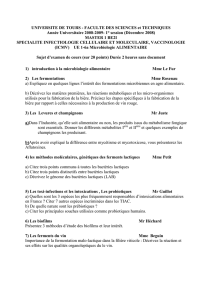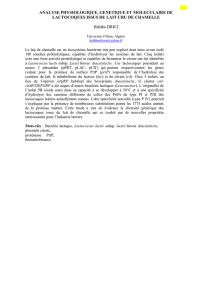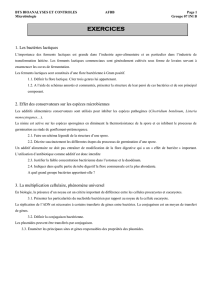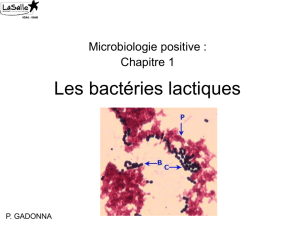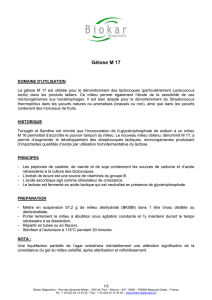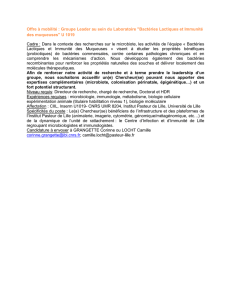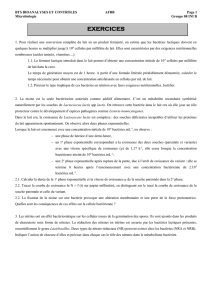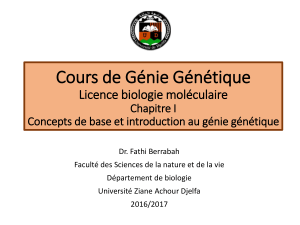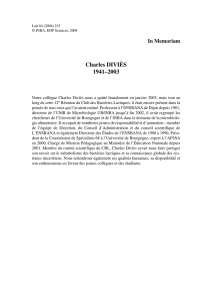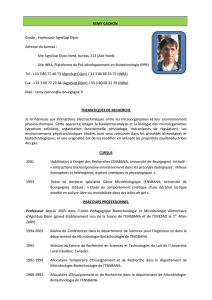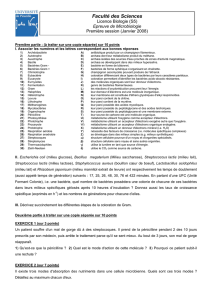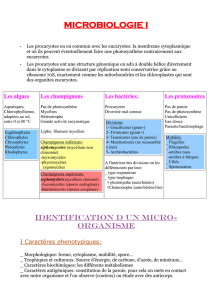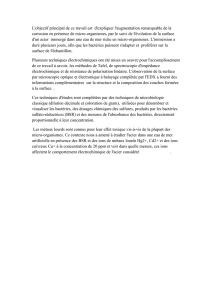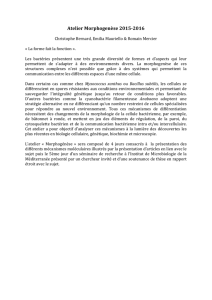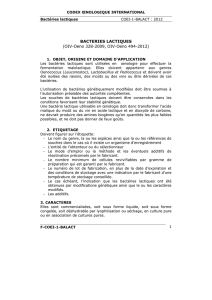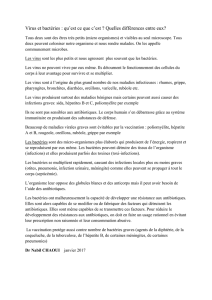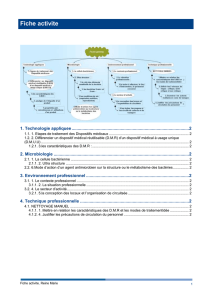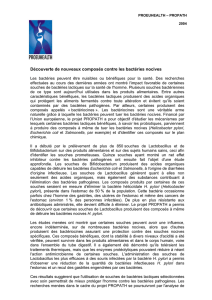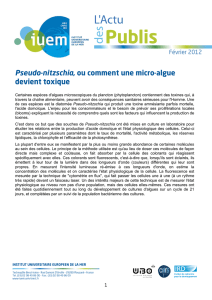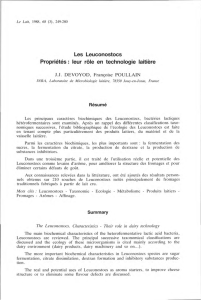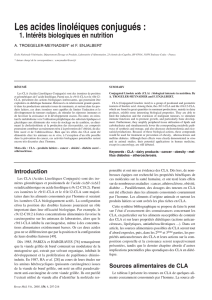II. Classification des bactéries lactiques
publicité
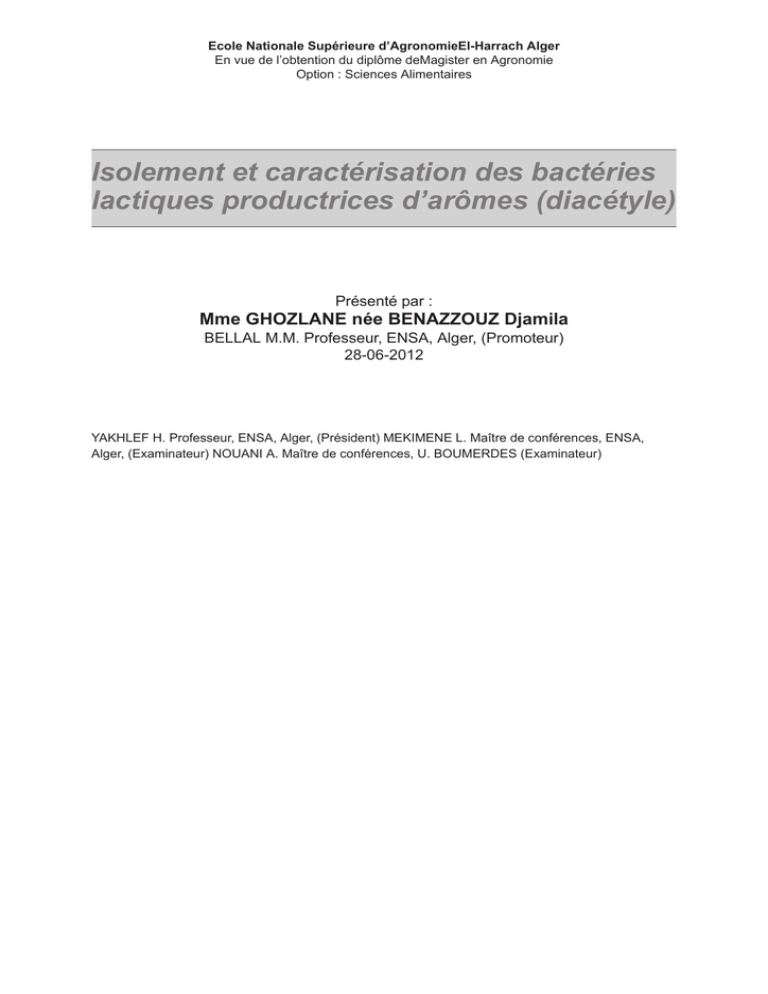
!"#
!!!""#$%$$&'
()*+(*,(
-./!0/"#$%$$&
'.1%!"2
#$%$
$&3'%4%1"2
#$4" 456&3'
$%&'&
"" "
(()*
$" "
(&" "
%&" "
+,-." "
&&%/&" "
*" "
)0*$(*12
$ * *(0*3!" "
*4&%&5&1&" "
*464"/&%&5&" "
*474)&5&&" "
*484"&&" "
*494%" "
*4:4*&%&5&" "
*4;4$<'&&=&" "
*4>4"&&&%&5&" "
**4)&&=&%&5&" "
**464)'&&&=" "
**474&5&5&" "
**484&5&" "
**494&%&" "
***4&=&5&" "
***464&/&=&5&&&'" "
***474&&&&&%&" "
***484(?&&%&5&&&&" "
*@4%&&%&5&" "
*@464@&=&&%&5&" "
*@474%&&&&A&5&" "
*@484%&" "
*@494 &&&&%&5&" "
@4B5=" "
@464=&C5&
=%&=&" "
@4740?&&%&5&" "
)0*$(**1$(*$$"" "
*4" "
*464&" "
*474" "
**4&" "
**4640'/" "
**474" "
7
+
8
)
9
,*
,,
,J
,J
,J
,J
,L
,L
,7
,7
,+
,8
,8
((
(J
(+
J*
J*
J7
J+
J9
J9
LJ
LJ
L7
L+
L+
7*
+,
+,
+,
+,
+(
+(
+(
**484$5&&=&&&5&" "
**494*=&&&&&" "
**4:4&D&5&5&" "
***4)&D&/&5&&&&'" "
***464$D&/&" "
***474)&&/&" "
***484&&&" "
***49B%1'<" "
)0*$(***1(!$$$"*)!*
" "
*4*&E=&D55" "
*464)<&&&" "
*474*=" "
**4&&5&&&&" "
**464&&5&&&&" "
**474&&5&&&&<" "
***4*=E<&E%&
D=FG" "
***464&=&=HD" "
***4740D&C%" "
*@45D&5<" "
*@464&" "
@*474I"" "
)&" "
(B(
)" "
<&" "
+J
+9
8(
8L
8L
8L
87
87
8)
8)
8)
8)
)L
)L
9(
,*+
,*+
,*8
,*9
,*9
,*9
,,*
,,(
,J*
"
"
Je dédie ce modeste travail à : Mes parents, les êtres les plus chers. Aucune dédicace ne saurait
exprimer l’affection et l’amour que j’éprouve envers eux. Mon mari et mes chers enfants Toute
la famille BENAZZOUZ et GHOZLANE Et à toutes les personnes que j’aime
7
*&&&%&5&&?&FDG
(()*
$
A l’issue de ce travail, nous remercions Dieu Le Tout Puissant de nous avoir permis de réaliser
ce modeste travail.
Je tiens à exprimer ma profonde gratitude et toute ma reconnaissance à Monsieur BELLAL
M’hand Mouloud, professeur à l’Ecole Nationale Supérieure Agronomique d’Alger, Directeur de
ce mémoire pour son aide précieuse, je le remercie vivement pour ses conseils, sa disponibilité, sa
contribution efficace et ses encouragements et surtout sa patience et son soutien qui ont grandement
contribué à mener à terme ce mémoire.
Je remercie également :
Monsieur YAKHLEF Hacen, professeur à l’Ecole Nationale Supérieure Agronomique
d’Alger pour m’avoir fait l’honneur de présider ce jury et pour l’intérêt qu’il a porté à ce travail.
Messieurs MEKIMENE Lakhdar, Maitre de conférences à l’Ecole Nationale Supérieure
Agronomique d’Alger et NOUANI Abdelouahab Maitre de Conférences à l’université de
BOUMERDES qui ont accepté d’examiner ce travail.
En guise de reconnaissances, je remercie Madame ANNOU BOUKHEMIA Saida de
l’université de BOUMERDES, Said de la DPGR, Baya la bibliothécaire, tout le personnel des
départements de technologie alimentaire et zootechnie, ainsi que ceux de l’ITELV de Baba Ali.
Une tendre pensée à ma petite famille pour leurs encouragements, leur collaboration, leur
soutien moral qui ont contribué à la réalisation de ce mémoire.
+
(&
(&
25 souches de bactéries lactiques ont été isolées localement à partir du lait de vache (cru et caillé)
et du leben, et caractérisées par la méthode classique, afin d’étudier leurs aptitudes technologiques
acidifiantes et aromatiques :
5 lactobacilles, 3 Pediocoques, 3 Streptocoques, 2 Enterocoques, 8 lactocoques mésophiles
(dont 6 souches acidifiantes appartenant aux espèces Lactococcus lactis ssp lactis et Lactococcus
lactis ssp cremoris et 2 souches aromatizantes appartenant à l’espèce Lactococcus lactis ssp
diacetylactis).
Le comportement de ces souches en culture mixte (binaire) a été étudié selon différents
rapports d'ensemencement et les résultats ont été généralement bénéfiques.
Le ferment local préparé par les souches de Lactocoques mésophiles et Leuconostocs, choisies
pour la fabrication du caillé modèle, ont donné des résultats appréciables comparativement à ceux
de la littérature, dans la production du diacétyle (arôme caractéristique) du beurre et produits
laitiers.
Mots clés : bactéries lactiques, diacétyle, acidification, arôme, Lactococcus lactis ssp.
8
*&&&%&5&&?&FDG
%&
Twenty five strains of lactic acid bacteria were isolated from the milk of cow (raw and curdled)
and from the Leben. They were characterized by the classical method to study their technological
capacity to the acidification and aromatization.
Strains are composed of : 5 Lactobacilli, 3 Pediococcis, 3 Streptococci, 2 Enterococci, 8
mesophilic lactococci (including 6 acidifying strains belonging to the species Lactococcus lactis
ssp lactis and Lactococcus lactis ssp cremoris and 2 strains belonging to the species Lactococcus
lactis ssp diacetylactis flavouring).
The behavior of these strains in mixed culture (binary) has been studied and results were
obtained generally satisfactory.
The local ferment prepared with mesophilic lactococci and leuconostocs, cjosen for the
preparation of patway of curdled milk, gave a good result than those reported by the werature in
production of diacetyl (specific aroma) of butter and dairy products.
Key words: Lactic bacteria, diacetyl, acidification, aroma, lactococcu lactis ssp.
)
+,-.
+,-.
9
*&&&%&5&&?&FDG
&&%/&
,*
:
I)16;"
:
J1<"
:
"
1
3=>"
:
"1?
3="
:
1?=@"
:
(
1
>"
:
K1
"
:
)1;A="
:
"16"
:
"(16=
"
:
1/"
:
"1!
@=
"
:
1"
:
BL1$
:
"1%
"
:
"1%
3=
"
:
"01%
@@"
:
1%<"
:
L/1
"
:
1@=
>"
:
1"
:
(L15!C>"
:
(4&15
"
:
!B)14
#
"
:
!$14/D"
*
*
6<$@E##
"
#$ # 3 #
"!>
F
# #>B
><
3$ " ; #
>&
G
>'$>#/
$=@<
>#
"
>
=$
H=>
$
<
#"
6#$=@<
=>#
G
#$
G"
!
<
@
>" ; >$ >"
!F#
<
$
2
<"
$##$
3<
@3
$
" ; @@ E "
! =$ @=
$
@ > " 1 > >
=$#H$
E
"
! =
>>#E
#&!I$,98J'"
##$ @ @
3$>
$
@
#EF$3
#"1
$
3
E
>"
4
(,((K;$>/ &,9LJ' < E $ > # "
,,
*&&&%&5&&?&FDG
>$ 3 = <
!
E/
L$J$
>
=#
$$>=3=
?>
=
3=<@>E(,K;&M =$,9J9'"
6 $ E =" ! $ 3E
#"
>
3<
##$
>
F
F#N$
O
#
#
$
@>"
% # < 3$ >>
"
% $ < # $ @
$@$"
%#=&
=
E
&'"!
##
F
,(
:
>
&
='$&<
'"
:
@3"
:
#
="
:
;
#3>#
$
>#
>P
=Q"
:
=#
E
##"
)0*$(*12
$ * *(0*3!
)0*$(*12
$
* *(0*3!
*4&%&5&1&
*464"/&%&5&
! > 3 > # @ " ! < $!,)8J"
/>$ E F !$ !$
B < $ ;$
$ !$ !$ !$ $ $
$ D$ M$ I 3>
@>&R
$(**JB!S
$(**L'"
*474)&5&&
!
>
#T,9,9
$ E # > E @=
= $ # C "
1 3 U U
> > # >" ; $ 3 > R &V' &3$ (**L'" W 3 #
$ >
@=>@>E
F @ > > &. $
,99)'"
!> &,99*'$ > =
@@ @@$ R # &V' # @>
X$ $ $ $ $
=@3=
$
"
;
$ @ & ' 3=<"!
>& $
,99+B!$,998'"$>#$
$
@=
<#3&6$,99L'"
6$>
>$/&(***'><
> " ! ,J
*&&&%&5&&?&FDG
>
>
(V
$
(V
##<
<>E"
*484"&&
! > > A # E ## &3$ ,99)'" ; E@
&#
>$>$
'&$(**)'"
$
<
#>3
#$#$<
&/@A$(**('"
6 $ < <$ E 3 " !
$##
#>E
<<
$
>@$
&# >' 3 # < <
&$(**)'"
! E # "!
>$>
#$G
G
>@#
@< E / &$ ,99+'" 1 <>#
E/"!
E3&
3=@
'E
"
! $ # & <' $ @=
&$Y'$
<"
!
#
#,)
(**L>,7
,999&5=
$(**+'
G
@E
#>
"
! # > E ##$@>#>
$
3
>"
$1
@3
" 4 > @ #
&/$,999B/@A$(***'"
! > &(**)' > 3 = > P > Q" ; >
P >$ E E $ 3 ## # @ E Q&R@#$,99)'"
*494%
!>>$
##@>
$>$@#
,L
)0*$(*12
$ * *(0*3!
3
>E
##&$,9)L'";$
$XE
@=>$
3<
##$
@=@>>$@3
E"
!><#>
$
3&$@$#$'$
#@
$>O
#"
@3@<"
E#SE@&,*Z,7[';(&/$(**)'"
#$
&5$(**,'"
! > # >
#&;$(**('";
$G$$<
#"
@<$>E
$
>
>"
*4:4*&%&5&
! > < E @ " ; @ 3 &\ $
(**7'>
E
R5&R=5A
#'&.@$(**7'"!>
F
3
<F
"
6 $ 3 E G @A @ @A $ ## # >" $ ## #> >&$(**L'"
$ @ > < $#>@"$
>3
"
*4;4$<'&&=&
! 3 < @> @>
##<
F
<";
:
!=
$@>
"
:
!
##
>$>$
>$<
#"
:
!
3@"
,7
*&&&%&5&&?&FDG
:
!=@<
A=&
'$
&3=@
'$
"
:
!3@"
*4;464&'&5&
!>@<$>
#
3>"6<<@>$
3
>"
:
&5&FG1#@>]
*$7E,$7^
<
$
$
@
";
&
$(***
.]@$(*,,'"
:
&%&1
X$
*$7E(^
<
,$7E,*^
$@
&65$,9)+'"
*4;474&'&D&5&%5&
! ## 3> > = < < @=> @> "!
##@=><
# > &6!>$,99L
$,99+'"
!<
##>
:
!>
>
3"
:
!
$3&@@
@'"
:
!E3=<E
##
@
"
:
!
E
A
>"
6 F$ < E @ ## >$ > E $
@=
=
3E
##
/"
!
E
<
<#
>"
6 # F @=> ==>>$
=$
3 ! = !>$ # 3"
*4>4"&&&%&5&
,+
)0*$(*12
$ * *(0*3!
RX E ## #>$ > $
$
"& $ > > # # #" !
> $ @ > > < =$ E
>
#"$@A
7E,,[
#A@>>
$
<&S$(**,B.@;@
@=$(**('"
!
###>
@>
<
><##>##
#=</&I$(**LBR$(**7'"
"&&$>#>
>UE
E@
E3###>
#"!<
&$(**L'"!@
>
##>
@$$@=@"
=&$>=
E#E#E
E
<
<>$
$$3"
E #$ E # 3
$>
>
>
& $,9)9'"
6
$#>
$#
>$=
3#<@>
3
#"
> > $ >
" ; $ # =@" 6 $>>@=>@
> " ! > # $ "
**4)&&=&%&5&
**464)'&&&=
,8
*&&&%&5&&?&FDG
!<#
>E
@>$@>@=>,9,9
T"
! > @3> > $#&.$
(**,'" ! @> # # >C<@@=>
"
6< !
S &(**)'$ @= 0 $
;
=@"@=0E
$
>
#
:
:
:
!!$
"
!
!$I"
$!!"
!3>
>
>>
> " ! 3
>
=ZD&R=
$(**)'"
!#&@
>
5%>
&,+' =&(***'@&(**J'"!
>3
,)
)0*$(*12
$ * *(0*3!
! # < >
5%,+>
<
<
!
=&DR'
=
<
>"
!
6%@=
##
< 3" ! R V ;= &R Z ;' [
@
&JLZL+['$!&J+ZLJ['
&JLZL(['&@#$,9)+B0S$,9)9'"!
&RZ;['
<
<@<
<E
J(E7J[$,&
$,9)+'";
$<
!$
$!$
R;[
6%
#E7*[F
@
;
$
@
=R;[E7*[$
#
&_
$,9)JB_
D$
,9))'"
&
$,9)+'
! > @ =@@"
GE/`L$*
ZL$7E/9$+/J$("
<
E & ('" # <
# =>=>3>
$
>=
> &;0A
$,999'"
,9
*&&&%&5&&?&FDG
!
&3$(**L'
&1
V1#M1#MN1<M
"
'IF#
"
%'D=
#
@#&'@#&V'"
'0>
;(
'
)[%;"
'
>"EE"
<
!@=>3
##
>
@=>
&#,'"
(*
)0*$(*12
$ * *(0*3!
! " #
"
&3$,99)'
! > 6%5,+"!
3
@& $(**J'
!
$!
!$G
U@$>
>$3!$#
M" ! !$ ! @$ >> >$ !$#;>
=>
##
"6$
@
<
EM="4
!!#
$ I$ ## @=> @#$!$P!
Q$ # " 6 3$ $
@>
@=>@=>
>&3$(**L'"
D3
>
F
@=$
@= a1110"
;1 "
(,
*&&&%&5&&?&FDG
11!"
**474&5&5&
E#
"!
@2 " ; > @2$
R V$ &'$ $ # &/ $(**)'" !
## = #>&@@>'"
! > > 3 # 3" ; > >" $ $ !$ $!$ $ $
$D$M$I&/A#$,998'"
:
&&&E&&11
"1<#>
#
@>&
>
=
3='"1<
3
EJ8K;"
$
##>
#=
<
"&_
W$,98)'"
#
#
=
>>G
#$
=
=
OE#
";
#
>&0A$(**J'"
:
&&11>@#$
>$
;(
@B
@$&'"!#
<;R[
<
&<
$
%&
'
'$
&-I$,9)9B! 3$,99J'"
! E ## > 3 & ('" ! ! 2 &R
$(**J'"
! ! @#$
>
>$
>E
" $ 1 ##< > # @ > @#@"!@=>
!
&;@$(**JB$(**8B
/$(**9'"
6 <$ !$ !" "
;$
>>
=
]E
"
((
)0*$(*12
$ * *(0*3!
:
0&11
>@#
>
##
"
!
@"!3$#
=>E$
#
"!#@>
#
>>&
6"!">'"$#>#=
!
";#>@
&R
$,99)'"
**484&5&
**48464)&5&
E0
$R!$
3
$
@<&D$,997'";@>
$>
"
!!
>>"1#
ER#
$#
>$
@2
";<
$
3=<$&'$
#<
@"!
@
E
#E
@##
"!
(7KEJ7K;$@
"!
2E,*K;EEL*K;"
!@
>$#
#$O>
>GN
"1F
@$
#$
&6$
,99L'"
$ < < <&R
$,99)'
:
!"!""
:
!"!"
="
:
!"!";"
! < ## < >$
U U" #
"(")<
#
="@
@$
=
U
$@@
"
!
<<
!
J"
(J
*&&&%&5&&?&FDG
"'
" &R
$,99)'
D%&
O1B1M/1B1
#B1
B1
"@01]B$1B1
@B&1B)1
B10I1
"1B1@B1"
**48474 &&&&5&
! > # =@> >$>3>3
&L'B1
3$A@@$>
# &. $
,99L'"
(L
)0*$(*12
$ * *(0*3!
#
&.$,99L'
D%&1
O1EE1%>E1E1
"
**48484(?&&5&
! > U
U
#<"1$&%$,99J'
@
#
"@
"
; @ $ # @$ # ## #$ # # W$ 0$ ;
@B#EX;$ $F>$;B
(7
*&&&%&5&&?&FDG
#EX;@
$R
$
#EX
5>#$RA&03$,99JB!$,99L'"
_#$
#>
#
&/$,99('"
:
>
!
>
#
>
@<$
>
<<@
$
&@
$,99L'"
>$ 3 > # &
U'3
">$U
3
E/
L$7&$,99J'"
:
_=&,99)'
>
##
#>$
U
@=
= G U #"E
<
E > = U
@=
E
&7'"
$!
"*"
&@
$,99L'
**494&%&
**4946"=&5&
!!
#
!"1
< > # > &< $ #$ # @Y'&T##$(***'"
;
8*<&
<'"
! ! > >"!@
!
#
@ &# '$ # @E
="
!$"!
>
#7*[
#
&3$,99J'"
(+
)0*$(*12
$ * *(0*3!
@
>
"
3$##$"&3
$,99)'"
T&,9,9'
!
D@$ F$&+'"
*D@
; @# > # @3 =/## &'" ; E
L7K;"<
#Y" ! >
>
";@><<
<E#
"
** ! < @ #$ >
# @3 >$ > @ ;(" &M
@ # + @@ @=
C @@'" 1
>
>&M@#
=
@=
J@@C=.C
@=
'";
;(
#
"
***
;@###"1
@3 > @# =@## @#
>>"1
;(
#
#
&/A#$,998'"
!
@=>E
>
5%,+
>!$!
<&
<@><
##'&@#!
S$,997'"
! < & $
#$ @$ # @$ 6 =$ !"
#
@@"
!
=
HE
@=
#E
@
!""6&!"$!"$!"$!"@$
Y' ## #" ! !" @$ !" !"
@@
#EX"
_#$_#$!"_##@
E # " ! # # &$ @$
@Y'&5
$(**7B0
$(**)'"
&(***'$ < @=> E # !>
##<
T&,9,9'"
:
!
_"
:
!
"
(8
*&&&%&5&&?&FDG
:
!!"
!3
##
+
! $ ,
<
>&0$,99,BR
R@$,99('"
6 $ > # #<$ b
< >$>
"
!#
>>R5
&R=5
#'#
$
=<$
E##@>"
%'
+
-(././)
(0112)
()
)0*$(*12
$ * *(0*3!
**49484 &%&&&
**4948464%&&&&
% &,99J' ! >#
>"
!>#@>$
=@#&'"
!> # @>$ = @@E
$
@
"
**4948474%&&&
!
@$
E$
#
c$
@&R
$,99)'"
**4948484D&&D&
! > > @A !
@#@
!=
E@2#
@=
=&6A
$,99+'"
**4948494%&&&
! F >$
U#
U
UA$
&;R$,999'"
**49494(?&&%&&&
**4949464(?&5&
!@G#
:
0
#
#
#
=_G&=
#'"
6#
=1&$5$R'
E
U#&T##$(***'"
:
0
! # # !"
U
#@
UF@
& $(**J'"
:
0
3
(9
*&&&%&5&&?&FDG
!#
3$@3$
$"
&06#$,999'"
:
!U
#
4
'
E0
#
"
4#3
#
d
_d"
6U < ! F # #$ # E U @ E#
#
&$,99J'"
**4949474(?&55
@_###$E
U#
@
$
$
U
E@&6A
$,99+'"
6 3 &_ $ ,99L B 6 $ (**(' $
E U# U E @ U # $ $ E U# @ U "
**494:4 &5&&&&
!>>
#
& /A#$ ,998'" #O
>
>
"!
@3
> > # >
E
>$>
/
@
& ;$,999'"
>$
>
E>
"$
>G>
#$
F # UE
>GE
@
@<C
"
***4&=&5&
***464&/&=&5&&&'
***464640=&5&
J*
)0*$(*12
$ * *(0*3!
! >$ #$ 3$ # U # >
=&$(**8'"
F$
#E
#
= $ > > @
#3"6##@
#
&
'"!
$
@
U
>
#"!$<
@>$<
#"
!@
U&D;1'
#
<#
";@
#3$
U$
U
## < $
U$
##
#N#3
X
@
#
"
***46474&&%&5&
!>##
3$
#$
<$
E # E # > &# .@$ (**8'" ; # =>
> # 3> F @
>>&R$(**+'"
! > # 3 3!$$!$
!$
#
"&! 3$,99J'"
***4647464&=&5&&
:
6#
!>
X
E
U
>
#"!#
#$ #$ " 1$ #> U## # &R
$,9)7'"
# # #"T>U#
,9<<$>
#
U
> " ! @
#
3>
"
!#G3
#"
#$
J,
*&&&%&5&&?&FDG
>#<
#>U
$
$ U 3 &6=$ (**J'" ! / >
>
>##
F
>
#&R
$,9)7'"
$
:
&=&5&&1
=
@>
3
O
"
:
&=&5&&&>
@
@"
@$
#
>$#E
$E
&
@$(**9'"
!#$
<
#
#$=$#
"
$@
3&I$(**('"
! > 3 # > " ; F # #
#
$
>&$(**+'"
***4647474&=&&&&
!#
#
#@
$
$
>@=
3 J*K;" ! > 1<
>
#&$
,999'"
;#
3<
@
#
"
L
#$
!@
"
F
@
XE=@<
=
U
"$
:
!
=
@$>$
:
!
=6!
@
"
"
:
;6!
@
"
"
;#
&;@$,99)'"
***46484)'&&&&&
J(
)0*$(*12
$ * *(0*3!
!
@#
3>
4
! # # 3 #
@ < @> U
#U
"
! @ # ( 3 ## @>F
#3>"!
>E
>
M"(&!U
#U'"
!U
E U > < 3 @$ @ > @> >"
! 3 3
< U
E # @"!
@>
@
< < " !
>E
U
>"
JJ
*&&&%&5&&?&FDG
!!
*
&
&;@$,99LR$(**+'
6G$>$
$@@
>
:
&5&E
>
&$(**+'"!>
###>
$
E
&@#$,99+'"!
>
#
"
!
d#d"
;3
#"!##
F
@3&$,99)'"
JL
)0*$(*12
$ * *(0*3!
:
0%&@
>@<&D$(**J'"
***474&&&&&%&
6>
$
>G
@$
@"6
$
> #" ; 3
&6G
$(**8'"
***47464&'&&
!
33
@<>@<" >&,9))'>
$ 3 3 " &,998' $>3
@
$
@
$#
E"!@E
>$>>"
#$3>
>@@>$<E##
="!
!
@=
=
$ > # 3 >
@@ = A= &@@ $ ,99,'" $ #> ;( > &T
$ ,9))'" ; !> & ' #
=<=>&
&!S /
_$ ,998' =< &- $ ,99+'"
"
& '=>$
##
"6@& '
>@"
***47474&'&&&%&5&
W
"#>
@
3$
"
#
@
3$
@&T
$,9)8'
&=##
#
3@'$
&=
###
3@'"
!@>
<
G
"1
3>
$ # B F
@>@@"1$=@$
#"
J7
*&&&%&5&&?&FDG
! > > 3 F><#<
>"
;#>
3
<$>
&3@$>>
#'$
"##E#
@<
@"
6@>
##$
3 # >" 6 =<
$>#
";
#$=
@<
&6
/$,99J'"
!##@
$
#@$
@
E@$
!@<
@ F E $
@@=@>
&/$#
'#
& !$,99+'"
! > E /$ 3
E
>
&$(**7'"
!##3>E
> / &6@$ ,9)9'" $ >$3=
@=
<"
<3
$$
>$#>
&/$ ,99L'"
! $ #$ > #
@>&D6A$,9)9'$@
!$
>>>>
&5@@
$,997'"
***484(?&&%&5&&&&
!>>
#
& /A#$ ,998'" #O
>
>
"
!
@3>>
#
$>
E
$
>>
/
$@
& ;$,999'"
;F
#
$E
$
@
@<
>
&M
$(**L'"
J+
)0*$(*12
$ * *(0*3!
6E>
>" ; >$ 3=
$>&
='$$3=
@=
<
& $(**J'"
***48464&5&
! > # #$ @< @ # @< &
@= $ $ ;
' &
'&@$,9)J'"
!##@
E
/
E#
"!
/
#
=>
@
&.@_$
,9)8'"
:
:
51G
#
>$
3#
$>$
/"/$
>
>#
3>
$";
$
E
<"&-$(***'"$<
>
##
$
!!>
@>
6!>& @M
$,997'"
511
@
>
@#$
#
&/$
,9)+'"!
>@>
>E
!
=&@
@$,9)9'"##$
#>
_
&L$8+'$_
&>>'$
=
E
>
B@$
& $,99,'"
***484740<DD'F77G
1 > 3=<$ 3=
E # 3=
E %6/" ! /(( ## @
I@$
,97("!>
=
/((3=<"!
/(( @
&;
$,9)8'"!@
3=
@=
<
E # ## 3=
&;$ ,999'" ! /(( F (
3
>3=
& '@=
3=&/'>
6% & =A_S_ R$ ,9))'" 6 $ /(*( =<
3=
$
@=@=&;%'$
3=
> @ E #E#&5/$,9)L'"#&(**L'
J8
*&&&%&5&&?&FDG
> =< 3=
"
"
***48484<D%F)7G
! > @# =@ 3=
&;('
" 3 > F 3> "D#
3=
&;('$E#$
&!
6A$,99*'"
***48494&&&5&
3 >$ = @=
G" M
&(**('$ @ # > @ > 3 #"
:
:
D1
$>
PQ
"!##
=
J*&T=$,9)('"1@
E
R##3
$>##
&T=$,9)+'";F>E
R#
=>ER#"!
=E(**^C@ER#$@E
R#EJ**^C"!
=#
#
>$L^C
#
"$
,
3
=
(E8^ B>
>B
$
=
=
#3=<
#&T=$,9)+'"
D11
E@>@
@=
="
>
@=
$
-
E
(7"!
@=
E,*,**@
"
,
&
6A
$,99,'"
***484:4&&
$ > =>
>#
#&55
=$,9)L'"
! "
! # E E R #$ #> @ $
/
">
3 E $ > / ##
#
## E / &.$ ,99J'" !
3
<"!
@
>
J)
)0*$(*12
$ * *(0*3!
##
ER#
"&.
=$,9)+'"
I T@ &,99(' $ $ " E 3 @ <
$
=<
@
"
& $
(**)'"
***484;4&%&
!
=@<>
3 # $ #" <
E&T_$,997'"
> F 3 " 6 = # > <
##&W
$,99L'; "
; # 3 E !
$&J@=
3=
@=
'$
#
&'>$&'
@$@$
A &; 0A
$ ,999'" ! E = @< E 3
#"4
@A>B
##&;
$(**,'"
:
!1&>'
#
#N
>
@
#"
:
!11
#@"
!111
>
E@"!
>F
$#
&$(**('"
; > !$ E#>"
*@4%&&%&5&
*@464@&=&&%&5&
!#
"1=<$
<
$eR
&#J'"
! # P Q > G $ @ A > < @#
&@6
G$(**)'"
J9
*&&&%&5&&?&FDG
! > 3 G &# J'" 1 @# &
=@##$'@#&
@@'"$
>
33
<$
3
#
"
!@#
3
>&;J'
&;+'";@A@#$>=@
DXE#>
$!$
>
E
"4;(
&$
@
>'
3=<"
! ## 3 ;("
@# $ @ >$ #$ @ B 1 =#=;"
3<
$=$
$
=@"
L*
)0*$(*12
$ * *(0*3!
!"3
&5=
$(**+'"
! A= > > 45 _ 6 #,$+@@ $ 7!' 3=7@@ @@$ !5 =_$89
@=
*@46464@=0
! > @# < >$
>$ > " ; E
3
3
D &D@ R=I_$ ,99L'" 6
> F # @
$
@
$@3&#L'";
=@>>
9*[
#" 6 & $ L,
*&&&%&5&&?&FDG
Y"'$
#3
$
#$
;(
@&;
>$,99+'"
*@46474@=00)F0&&&G
!>>#
$
>
& ,$) '$ $ @ ;( @#&D@R=I_$,99L'"!3
=
"
!@#
3#>>
@#>
E
$
@$
;(
D"
!#:
;
L(
)0*$(*12
$ * *(0*3!
&D@R=I_$,99L6G
$(**8'
*@474%&&&&A&5&
6 <
# $ > "; @# @$ < # ##E
##
"6##>
>
$
>
$
&;@$,999'"
! > < == =
>"!
E
@"!;
F@A<
#
&'
&;@$,999'"
*@484%&
# &f )9 '$ # # =$ E U ###"9*[
G
"&_$(**+A$
(**9'"
!
> < &
'$ ! & #
"'$ &, '$ $ ! & ' !
&
'";
F
>
#
A&! 3$,99J'"
63
>
# > ## 3$ < !4..=&,989'>
E
8$9.@A@
=#$>
=& $,998'"!
&#7'$@A
&=D=$,99+'"
!
<
A
/$L"77"7&RWX$,99)'";
A
7"7E+"*&@$,99('"
4#EU
$$=&;!'
3&/=;$,9+('"!U3
;( = UA= 3 @=
&6/'"!#
U?##(
=
UA= U =@ &!'" @ =@@ &D'
E
A=$
=<
3=$
#
U@=
3=@=D
@=
#";
=$ # U"
;>
3=]U
3=
LJ
*&&&%&5&&?&FDG
&!6'
#N3=
="!U]
=
F ($J
] "
!U$#$U@#>E
=A==#=&0!'$=
@=
&6/'
@=
&!6/'&/@A$,99J'"
!$$
;#
"
&S
$,99+'
"&&AD&&
)0E M )E ; =M "E 3 @=
M
"E @=
M 0"E = @=
M 0BE = #
=ME=@M"E?
3=M6"E
@=
M"E
@=
@=
M"(E
=
M(E]
MP7E
3=3=
=&A=>'4
!UA= ! / 7$7 # ## =$ > # U" ; 3> > >U>U
U3<
"
!U!6#$3>U
&6$,99L'";@A$A=>
=@<
E@2##
$&@$,99L'"
11 @A @ > 3= U?
= ] E U $ > @A
U$
3=##E3<
U&M@DG$,99,'"!
3=3=
G
U@
LL
)0*$(*12
$ * *(0*3!
=@A
@EU"
="
";
=U
U
>
U
="&/@A$(***'"
*@494 &&&&%&5&
*@49464 &&A&
$>
##=@<
E
A$
#E
3<
"3
E
>
>$ $ @$ $ @
&; >$,997'"
!
$$
@=&R$,99L'"!
F#
$
=&,9)*'>
##>
"
*@49474 &&/&
! G $ >
=@
&6A
65$,99L'$
O 3< " ! >
>3"D<
@
$$#
&!
$,988'&D8'"
&&# L7
*&&&%&5&&?&FDG
*@49484 &&&
3 # 3 & =$ ,9)9'" 1 JV
(V
LV
LV
$>0 $ $ $ (V
(V
(V
> &5 $ ,9+J' $ $ 0
&D $ ,9)7'" ! >
>"A&,9)7'
(V
"!#2
# > " 1 A=>
> "
! < E 3 A= 5%
=$ !6/$ %6/ 3=
&@
$ ,9)+'" ! ## > <E#
:
!#
A=>A="
:
(V
3#
3=<" E
3=
33=
"
:
(V
$ #
$"
!
"D@@
&,9)8'>
(V
; ";
E #3 A= $ E $ E #
"
@4B5=
@464=&C5&
=%&=&
@46464B5&&&5&
! # > E U ,)),$ > > " ; F @
#@#"<E2E
L*K;E/78"!U
>
$
gg
gg
#>Z6B ! 6!&D$,99J'"
!#
>$
#
$
>$
U$
#$
#
3"
L+
)0*$(*12
$ * *(0*3!
!#>>
# ## &$ ,99*'" ;
>
:
:
:
:
:
!#
#>
#
"
!
U
U3=
#"
!=#
#
"
!="
!U@
3"
@46474&&5&&&D&&
==&
!##
#>
E
U3
> " ; > # >
U&A$,999'"
6##<
>"
> &,99L'$ > @ # @
@#&!'@#&!'"!
"#
=$
U
&)'"
''
<
&A$,999'"
!>=
##
=6!$>#>"
>
>
>
E
$
#"!
$>
U
>E
$
#
#&;T
$
,99*'"
! > # > @ # UE
3 U
> !&V'" !
L8
*&&&%&5&&?&FDG
> # >$ > @
#
>$@A>"
>E
$
U
@=
>@>
U
#
E
U
@=
&.
$,9++'"
03&,99*'==
#"$
@
$
U
>U
U
#"!3@
:
:
:
:
!
!E63
#E#
"
6#=$!$
;($
#
=>
#"
##
#$
;(/($3E
/>
#F
@
3"
6#;@
=@
$
F3=
>"
@46484C?&=&C/%
! # # 3 > U$ H 3" > U
@>>#
#$
3
>E#<
&0
0A
$(***'"
+**>G>U
#
@@@A&; $(**('">
#3
U
U>
>$=>
###
E
U>
$U@$U$U
@=
$($J
="
! > E # # UG &$,99+BS=$(***'"
!>
#
## > == $ = =$ EU
#&
$(**8'"
@4648464DD&
@ <$ U
# > G E $=<
>
#
3
#"3>
> # @ " # # $ ==F
###
>&S=$(***'"
L)
)0*$(*12
$ * *(0*3!
!>
U@=
#
U&D'"!
$
@
$
LE
7["!#+
==@A"
! =<
@@#@@ = &=< D' @A >"
! ## =< D U## " E >
# J B ==> =@#&'$
6+@@
!
&6A
$,9)J'"
@4648474D&
!>$#@A#>$EU
#
#
&$,99*B.=@$,9)9'"
!U@=
=
=
#@>
#
E#
$
=
= &@ $ (**J'" ! = E@2E
=
$
>
";
U##$
#
=> # E X " 1 # =$ $ &S= $ (***'" !
#,*
##
E#
"
D > D &,99L'$ A= 3 @
3
3
"1>1
>3E
A=@A
>>U
@U>
<";
<
>
><&R$(**+'"
L9
*&&&%&5&&?&FDG
!%!
#"
&S=$(***'
@4648484D&
!=
U@>
#<"!A=>
$
<
&'
A=
#
#
&!03$,998'"
! > E =@ E
=@< > # # =< =>
O
UA&!S
/
_$,998'"
!=<=>
>
E$>=U@=
=
8E
,+
&.=@$,9)9'";
3
U
"
6
##=
@
#
#>
U
U
#<&!03$,99+B!=@
$,998'"
! # > E "!>
U > > UA= =$
3=$
&-5G$(**,'"
@4740?&&%&5&
7*
)0*$(*12
$ * *(0*3!
@47464&&&?&1"=
!
&hL**6'E
@>$
F
@<A
&5@
$,99('"
! $ "
DGF";E
>
U$
#
#"
!
#
&
C_
C_'
"1
>3
>G
#
>
"
$ < >
>
@3#
&$(**8'"
@47474&?&&&%&5&
4
U
3>#
>
&A$,99*'"6
#U
>
#
UU$U]
=&6<$,99L'"
!
=&,9+7'>>,$+EL$*
=
# H 3 # >U U
@=
H
#
& $
,99)'"
>
=
@=
>=
U>E
#$
U
>>U
>U@U
U
=&M
@$,9))'"
!U # > >" ##$ @=> > U
> >>>
&0$,978 $,99)'"
@4747464!&&%&5&
! " >
U$
U#"
$>>
= >U A= " ; 3< =$ 3> $ # >
U]
=&/=;$,9+J'"6
$"
=$
U]
< > " ! > 3 = # 7,
*&&&%&5&&?&FDG
)iC$&=JEL^C'"!>
U]
#@
(**^C>
J**^C"!
>
U]
=#
3 O < &# 8'$ $ U]
>
=
2$
$
U
=
"
!&6
"*=
"8>'.?0.@'
&;$,9)*'"
6
$
=6!6
=
]
U#N3
"!
3
=]]
"!
3
=
,(^C$=
EL7^C&D#T$,98L'"
!!
37^C
=)7,**^C
U]"
4
=
U]
6!!#)"
7(
)0*$(*12
$ * *(0*3!
!',
*#8*#A
"*=%
&;$,9)*'"
; < > <$ " " $ > > $ E =$ =@ =$
]$($J
?"
!?#E
3
=?
=@";F
3=@>
3=< =$ A=> ?Z 3= "
/@A&,99J'>>
#
" $ = > @# G 3 > U >
&#9'"
6 1 !U @=
&!6/' U3< %6/$U>"
71!U
=#=&0!'UC
/"
7J
*&&&%&5&&?&FDG
81!U
?
3=&!6'
U>"
91!U
=
&65'
>U@
U]"
: 1 ! ? =@ &!' U
>
!(3 ('B)(-
.//2)
!>
UU?
$U
@=
$
="!U]($J
>
&!T $ ,998 @_$ ,999'$
;@A >$ ! " #
&;V'"
! > > G 3 $ $ 7L
)0*$(*12
$ * *(0*3!
2
=$
]
;(3>
>3
&5=
$(**+'"!
"
@4747474&AD&%&
P ! > 3>
3
U
$
=
#
U?$
3
#
=]$>
3
($J
Q&;@6<$,99J'"!#3>=
#
#
=
/$$U3=
$>=
>"
@47484D1"&
!
=U
U
#&5
$,99)'$
#
3
><#&$<H'$=&!
$,997'$#;&/@A$,99('##
& $,99+'"
@47484640&D&5&
! = >
$ =
@=
$
$
$
@==3&$,999B$,99)'"
#
!
=>
@3
G<<
X$
E 3 = ;` > G @@"U#
U3<
I6$
=$F
E,","***$#G
X"
@ <
$
>&0"""$(**+'"
! = E U U
<#
#&$(**,'"1
"1>U"1E
>#
UBEUEU@"1
<
&9'"
$%Q40&D&5&DFB444E7PP;)AE7PPRG
77
*&&&%&5&&?&FDG
&C'
#&K;'
&K;'
6&CJ'
M!45
)+$*9
(EL,
)),
*$99*E,7K;
,L
!
=U3=
#$U#
U3=$
>
@47484740&=%D
:
@>
! = E @ > gg gg
gg
@= @=@= # ;/ ; ;/( ;/J & $
(**,'";
<EU
U=>
U
;
GE3$#
#>@=@=
&O>>'
#
! # ;/( ; !
@=@=$#
U@=@=3
=&;/(;'
#
#$U
#>
$3<
=
gg gg
gg
;1;/J ; ; ;/J&$(**,'"
:
>
_ &,9+)'$ =@< = > #
3
U@3U#
$ @> U@3 3 N # @==3#@=
7+
)0*$(*12
$ * *(0*3!
! # U
> 3=
E
@==3&;@$(**('
; $ $ F < ,9,J$ M$ >
@==3" ; # > #>#>$<#
@==3$
>E
U
U
>&_;$,9+)'";#
> " E 3$ > U @==3>3=
E
U
=>
!> F 3$ <$ #
"
gg
;
#;(
E@;/J ;/$>
#$$
>
";
<$
$<&;@$(**('
D3 &,9J('$ $ U
# ]
=@=
3=
=
>
$
=<=
@4748484<=D
6@>
U3
U"
!U
U
U>
&;@$,9)8'"
!3 3 ## > UE
U3
=$
UE
3&!6_$,987'"
!3 = U U E P2 Q$ F E U3 E U E U" 6 $ > U & U = ))K' U" 1 U 78
*&&&%&5&&?&FDG
#3
U
U
&;@$,9)8'"
!
##
=P
E 3Q" 4 # B #@
#&!6_$,987'"
6
=PE3Q$G
U
@
"D
>
"1
UP
>Q$
U
$
>$
<
$
U
"!>
#@
<
#@>#
E@&;@$,9)8'"
@47494B&==DS
!#3>=#
#
=/$$U3=
$>=
>"
@4749464==
!/
+$++$)"1@=@>
>##>&6A
$,99L'";@6<&,99L'$
U##
/#
U
>
U33
U
=
U]"
U<$
U@<3
>
U
/$
U
>"
@4749474==
!
=
U]
@
@"D&,9)('
@
3
=<(L@
"
D
>$ @ " 3 =
<+@
"
@ &,9))' > $ >U
((K;$ / L$) ;L
&
=$]($J=<='$;(&
@=
$@
'>#"6U< &,98*'
;@
&,99('
=U##>/#E7$("
@4749484==&
! E # > ;L
=$ ] ($J
&;@ 6<$ ,99J'" > ! "
#F#
$ U < &RWX$,99)'
7)
)0*$(*12
$ * *(0*3!
!U
&,99J'
>
=
U]@
U>
U3=<"!
U?$
=
U]
3>
,*C!
G&T
;$
,997'"
; > 3 = =C]3E
,)K;
,**[
U3=<"
@4749494==&&5&
! /= ; &,9+,' > U =
(V
(V
&' $ " 6 $
>3
A=
3#$>
3
UA=$&/=;$,9+J'"
._&,9)8'$
U##
>
=$>
#
(V
U
; >##U
="
@47494:4==C/C
&,99J' > >E @ 3 "$ 3 US &S j *$97' > " ;
$ # > F$ U
> < U
<"
@47494;4%
!
#
U
"$>
,,*
=
(J*E7**C!
U]&6$,98+'";
$"
F>$>>UA=
=
$
=&I@;$,98J'"
@474:4"==&&&D
@474:464CD55
! > E > > #
>$
]$
@=
$
=$
$ > $ > #
#&R$,99+'"
!
=&($J
'$
3=
$G
##
=@
& $,99L'"
@474:474CD&/
79
*&&&%&5&&?&FDG
!
>
@ &5
$
(**,'" ! # 3 # E "
##$ = @
>>
$@@=@>
$>
U
#
&-$(***'"
$ = G #
U
>&T
$,99+'"1F>
U
>
&;$,98('
>
&$,99L'$UG
=
""
$
>
=;(&@$,99J'"
!
UU##>/#E7$(
&;@ $ ,99('" 6 # = U
"
6 3 $ " #N @# =E
3
$E/E
&/@A$,99,'"
!U > G U
#"!U
U
>
E
3=
&;('
="!
=
$
##"
!;(
$
U3
=
#&R
'"
>$ "$ U>
=U]&/@A$,99J'"
4 U< > &/@A$,99,'";
>
$
$U"
+*
)0*$(**1$(*$$"
)0*$(**1$(*$
$"
*4
*464&
!@
>@&>'
E
@$
:
:
:
6#1D!M
& '$"
6#&#
@'
$
&'"
#
G]&S=
<'"
*474
*47464<&=
!
34
6>&'DA
&,987'=
@@
>"!#&@$
(**J'"
(&'&5@'
@@
&3'"!
###&!$,99,'"
D< !" ! ##&!$,99,'"
J
7
D
&,* E,* '@
EJ*K;
L)@"!
@40;
&#'
@
="D@
3"
*47474<&D55
:
:
:
!"
3
@>"
3
@>"
*47484<&/
!3
+,
*&&&%&5&&?&FDG
&6>(D<&@'$E
&,*E,7G'"
$E
&'"
*47494(=&5&
:
"
:
3="
:
"
:
0@
k@
:
1
/"
:
@=<B
:
!"
:
%;"
:
%/"
:
:
5#
%"
:
"
:
D
"
:
D
"
:
M
R"
:
M111"
*474:4D&5
)
;@=>
##
&9
%;C
'"
**4&
**4640'/
!
@
$#
>
##>"$
@
#
G"
!
@
#
(7*<
$@>&$$
Y'
E#
ELK;$G>
="
**474
!@
>
$
1
+(
)0*$(**1$(*$$"
:
!
@$
#
$
"
:
!&
@E
:
!&'$
@&
#E
<'"
!
<EF
G
G>UE"<LL@E(*((K;$
G
G
U>
E,*[
$#
>
@>#EU"
**484$5&&=&&&5&
**484640&&F"&&G
,*
#E
"
,
E
"
1
> 9 @=>"
#,
3<"
7
6F#N$
##&G>E,* '"
**48474*&
!@>
$UE
" ! @
"
#
<
#&R
$,99)'"
!##GF
@"!
J
&'E
<
&,* $
L
7
,* ,* '$EJ*K;
L)@"
!<,
@>@&
@$
!'$,&
'$>GE@=>"
,
8
<$
,* E,* ##@"
>&>
>
$
GEL$("
**48484"&&%
!
GE
J*K; 8( @" < $ +
&9!'G>E
,* "
,** ^! E &*$, ' E @> ,
#
2
5
#&,*" +J
*&&&%&5&&?&FDG
'"!EJ*K;
L)E8(@"<$
,*[
##=
##
5
R
"
&M
33'"
!$!$#
!B)L`
3,CM3,C6
"
"
@
"
**484940=
!#E##
>##>&
@'G>UE
@<"!#
@#@
&R
$,99)'"
!
@#
>E#
<
R$@@
<@>>
&3'"ER#&V'#&'"
6<3F
R>###";
<
3
$#
#
"!
ER#
ER#
";
##
3
&R
$,99)'"!
#&,*$,,,('
@
#
!>$
!!"
+L
)0*$(**1$(*$$"
!)C
&65$,9)+'"
+7
*&&&%&5&&?&FDG
!C
&;@;$,9)('"
++
)0*$(**1$(*$$"
!C
&;@;$,9)('"
**484:4)&/&&&
F
#
$@#
3
,*[
=E
(*K;"!
#
>
@
3#&'$#
=@
3&,*$,,,('"
$%6P4*&=&%&&&&
+8
*&&&%&5&&?&FDG
6## ,
,
#=@
U
@=>"
(
!<
&,$($J'
@
#
"
J
!
EU
UG
UEL7K;C8(@@@EJ*K
@"
L
!=
$
"
7
<##
U
#
$
E,*[&C'EL7KC(L@
@@EJ*KC(L@@"
+
>&J'##G>UEU
U@>><
@
#"
8
&(*K'
#"
$%664*&=&&5&&5&F5&
&&G4
"==& &&
&
6
,
#=@
U
@=>"
7
!
<
&J$L$7'#
EL(K;CL)@>@@EJ*K;CL)@
!>"
8
!
=
$
R###
"
9
4
>
E,*[&C'EL(K;C(L@
>@@EJ*K;C(L@!>"
:
>#G>UE
@$#
>##<@>
>"
;
!@
E(*K;
#"
$%674*&=&&&4
+)
)0*$(**1$(*$$"
"==& &&
&
6
,
U@=>"
7
!
<
&J$L$7'#E
J*K;CJELG"
8
!
=
$
R##"
9
4>
@E*$J[
3
E,*[&C'E
J*K;C(L@"
:
6
R##<@>>#
@"
;
F
#@#
E
(*K;"
**484:464(5&&&&=&
;@
@E
"!@
ELK;"!
@
&@'"
$
>"
**484:474)
=
@
E"##
G$ !DR&
=G
=&;@$(***'"
!>>
##@
>3 &(**,' _@@&(**+'"
**494*=&&&&&
**49464&'&<
;E
&ElE
'
35,8"1
#$
$$$
$
"
**49474&'&5&
;
##3>"
@
$
<3"!
@>
#"
B&
!#
E
$
@$
#3
"
)
+9
*&&&%&5&&?&FDG
!
##
R$>
3
RVR"
&1
G
(L
@"4#
"6
>#
,$
E"6@E9*[>#$>
#@
J*
"!#&=$T'
,*** a"! = R#&V'
>3R#&'"
**49484&'&%5&D&5&
:
!=>D
A=$<G
$
3
3=
E,*"
"
!
##"!
3=
@=
<B
#>
>"
:
!
" ! E J*K; ( E 8 G" " ; A=>@@@A@
$!
"
!#
A
"
:
D
!
@3E
:
6PI9:I)$@
%=@
!"5"!"
8>I9:I)$%=@
"
8>I)
=3!"
:
;
@
:
:
6## 3 @ F " %;$E
##/@$3
:
:
:
5"
,8>"
=3!>"
!
@
@
%=
@E
:
8*
QE;$!$/9$+
%/&,%'"
)0*$(**1$(*$$"
:
:
$/
E8
G>E7
>&,%'"
:
;
%;
!3
([$L[+$7[
%;$EJ*K;
(EJG"!
"
:
D@
! @ @## " 63
E+*K;
9*$E+7K;
J*"
1#
#
<@##"
<#
$EJ*K;
L)@"!
"
:
;
@
!
@=<
>
@
$
<"
6E,[
@=<
(L
EL)@EJ*K;"
:
;
!
3
/"!
E"
!#
"
:
4
>
#
E>
"
:
"
:
4
&=>'"
:
!
]
M_S
" @ 3 $
!$!
"
!=@= & ]' M
_ < J E 8 G E J*K; &1
'"
,
*$7
#E?@,
%/E
,+["<
,*
>
]"
;#
=
?
@3"
:
/=
=
!@=
= @
E &1'"<EJ*K;
(EJG$
"
8,
*&&&%&5&&?&FDG
:
6
@@&5,8@'E*$J[
"<(
E+G
EJ*K;$#
G
#
%E
"
:
0
3
#>3"
<JE8G
EJ*K;$
H E # # " @!$$"
@
!$@#"
!
@
!
$$@##"
1
##@>
"
**4:4&D&5&5&
**4:4640/=
!
@><
##
@ #" ;@ &(**J' F
"!
<
$
G
$>#
/&
6'& $,9)7'"
:
:
/<"
##(*
@
%/%C9$@@&E,['
"
"3
#
>"
6I"TPE65L&$,988B!5=$,9)9'"
#
$@
$>
3
#E(L@
E,*[&C'"
$#,**
E,*[&C'$
@E*$J[&C'3
!$E
E3
,[&$,988B;@$
,9)9'$
,*E
,*>3
3,*$,,,(4$/$
@
:
:
:
8(
<,*
"
G,E(
@@&E,[
@=>E
97K;'"
%C9G>E<"
Z
!
E
6&K6'"
)0*$(**1$(*$$"
!
##
F"
**4:4740/5%5
**4:47464D&&&
!=$
<$
#
@" 6 # 3 H F " > >$
P
=Q"
**4:47474"&D
! ># = @
> I@ ; &,98L' &,98L'" ; @
#
#
>
=#
@==3
@=
3=$
@= =3 #3 $ 3 # # "
! @< &_
'E7J*&I@;$,98L'"
!
=E
<
@$&
'$
3
="D
E
=
J##"
<$
@&)'EE
(* " ; E (,K; (L @ >
=
"<
(*
E & @' E )*K;$ 3 &,*' "
,$7
@=
3=GE7
"!@##G>E
87K; (* " !> <
*$7 @@G$#
EB,$7
G$
*$,
0L"<3$GE,*
E
.(/LEJJ["!##<,7"
**4:47484(&&&&&
! @ $ @ > # =" <
A= > # .;#
#A
"
**4:47494/D5
!=>
#N
3
"<
E J*K; J E 7 G$ = > # & 8J
*&&&%&5&&?&FDG
' B > & ' B <
@
&
'"
**4:474:4/&5
!>F@@DS)*&1'"
;
@"<$
> @ > $ @ H E "
**4:484"%&&%&
#
@>
3$
=
$
3
"<
>
$>E
3
1L>1L`&,C,B
,C(B(C,'&/$,9)9'"
***4)&D&/&5&&&
&'
6
$>
#
$
#E
@@
#"
***464$D&/&
1 3 = > > $ E 3$ "
6 3 3 3 = $ U U
U U" ! #
@
#
$ > > "";
<<3
#>U
>
U
"
3>
U>U"
***474)&&/&
!
= U$>
&
#
'$8&
&'"
!
=6"
U"
8L
)0*$(**1$(*$$"
! = 6 E # "
U"
!
=%
>"
***484&&&
3$@>
3
B>>B5
"
!&E
,**,
'
#
,7*E(7*#$>E,7E,(*K;"
,**
E
([>3
#3$
(L@$
>
##"
***49B%1'<
***49464)<'<
G
@>
#
E >$ > @3 <3
>"@>
3
#>3
##$3>"
; @3 $ # <" 1 > <>$>#
@"
!4/D$
@
E*$(C##
#
@>E$<
<&/;#$,9)8'";4/D
@
#
=#NE
@=>"!G
E
,)*^
@
##
"
!#
E(JK;G>E>/
L$8"
!#$@<
_7
GE8K;&#,J'"1
>
=
##
&/;#$,9)8'"
87
*&&&%&5&&?&FDG
!"
D<
&=6'"
!3
@<
##=>
@
I@;&,98J'$>E
&J'>&,'!$
<
$
"
E<
;
$##
$U=
=!!$>
#
,'63
U"
('
U
@"
J'
/"
***49474B&=%UV
%#
P#Q#3#
";@3
E,,*K;
,7"
(
D3
U(",* "
8+
)0*$(**1$(*$$"
D
U(,K;"
88
*&&&%&5&&?&FDG
)0*$(***1(!$$$
"*)!*
*4*&E=&
D55
!>
<#G
#
@3
<
@
@
&65$,9)+'"
#
>
#$
E
H $ @@<> # @ @ 3 E " ;@> @ F #$
&#,L,7'"
*464)<&&&
##@
3&
@
3#PQ$'
#
#>$
E
>$
$ER#$
$#
X
>"
! @ @ !$ ! $ !"
! > > @# +$7 [ %;
> E " ;
1 (* # < ## > @# @ E,
@E!";
<$>
E+$7[
%;&>
@
<
'
#E"
"B>>@#
3<
"!!
>
@$
#
$
<"
*474*=
*47464&'&<5&
8)
)0*$(***1(!$$$"*)!*
< # &# ,+ ,8'$ E #" ! # 3 > &
<3'>$<
R&
<
@>'"
!3>>E
3
,8$ 5$ =3$ > > @$ F
>!>$
!$
!"
!#C $.E
!$C
$>
89
*&&&%&5&&?&FDG
!%!
$.E
!&!
$>
! ,J > > @
@$$
#=@"
)*
)0*$(***1(!$$$"*)!*
"'
<
&
<
*4746464)'&5&
!U>
3#
&;> X'"!
>&
>@2')*[
b###
!$!$
!
#X@2
!(*[
###"!
3!&,99,';@
&(***'"
*4746474)'&<
@$
3
#E,*K;L7K;BE/9$+B
+$7[
%;
@E+*K;
J*&
@'"!@
E#@
<,
$
#
D
$@
< ,
" ! > F #
#
"
>
!$@&)'<
E
L7K;$
@>
!
),
*&&&%&5&&?&FDG
"$
3<
#E+$7[
%;
]$>
@
<
"W@$>
##<
<
E/9$+$@
<&,L'"
##E
U_
$
#@
"BW3
@
!E
@=@$
@
"
!
!
#EJ8K;
@> 77 K; ,7 $ 3
<
&,7'"
*47474"&%&&&5&=&
RX33
#
R
&,99)' $&(**,'&3'$
@
#$
#@
"
! U !$ E U3 ! > > @PQ"
!>>#
!"!
E
U
G>UE$
@$E
>$
HEU##@
U
>"
R +(7 $ (7 # # #$ > @ E 7 7(*[
!BL,+[
!$ ,+ > +L[ ) !> E &J([' B L ! &,+[' B ( > &)[' B J >&,(['J
>&,(['"
!@
&7*[<$J8$7[
<
,($7[<""
! @ > # < @
# # &
" ' $ <@#&
'
@#&
"'"
! @ B!
C
#3E
F3
&6!>$,99L'$>3>3
" ! @ " ##$
#& $(**,'"
!
@
@$
$
#
3,L,7"
)(
)0*$(***1(!$$$"*)!*
#>D (
)
V$$
#$;$
5
$/@#$!;!$
!;m!&#'$!!!$
!!m!&#'$!6!
=$
!6m!
=&#'"
)J
*&&&%&5&&?&FDG
$>D
V$$/@#
!;!]
$!!!"
**4&&5&&&&
**464&&5&&&&
< # @ >$ < @@ @<>
<
$
E
#
E
"
)L
)0*$(***1(!$$$"*)!*
! < < @>@@$!
_ $ ! _ $ ! @$
! $ ! $ ! =$!!
"
6 $ < @>
@ > ! !"
**464640/=&5&F5&&&G
&&
! # > @ < >$
>
<<@
$"
> # < >&& $,9)7'"
!
/
E(L@
!> ! > 3 ,+ E (J &
3'#,)E(7"
!',#*
;
*
)7
*&&&%&5&&?&FDG
!(,#9;
*
!),#*
;
*
)+
)0*$(***1(!$$$"*)!*
!,#9;
*
!,#*
;
"*
)8
*&&&%&5&&?&FDG
!",#9;
"*
!#,#*
;
*
))
)0*$(***1(!$$$"*)!*
!$,#9;*
% > @
3 ! ! 3 < @
,)K6 / +$L +$7&# ,)$(*$(( $(L'
#,9$(,$(J$(7'"
!
3 (L @ 8(K6$
E/
L$)$
@!!J"WE@
!!m$),K6E/
L$7"
$@3<!;,$!6($!!!;,
> > (L @ 7+K6$ L)K6$ 77K6$ 7*K6
"
!@
#!6m$!!m!;m7)K6$),K6
+,K6"
% > < > @ @
&@
'3
>>
<"<@$@
#N3
@>
##<@
F<&#,)$(*$(($(L'"
6<;&,9)*'$@
#"!5=&,9)9'$=
!>3
$
$
>>@
E
87K6$@@
"E
"
##$$>@!!,
#"
65&,9)+'$
##
E
>
E @> @ 3 < >
<
E
E
)9
*&&&%&5&&?&FDG
# =" ; ## E 3 #
=<
AC
#&!S$,98+'"
!$ ! I &,98J' 6=
&,9))'
3> # >$ F < !>3#/$#><#
>@#E7*[
>E
"
E>
#$<
!
#><&6=
$,9))'"
**464740/5&5&F5&&&G
&&
!%,#
";
9*
)0*$(***1(!$$$"*)!*
!&,#
";
!',#
";"
!(,#
";
6<=>#E
=
>
=
<
,+@
&#(+$(8$()(9'"!3
=
*$)8*$8*!6,!;,&3(L$(7$(+
(8'&3'"
$ < $ 3 *$*+*$*87 $
*$*L7*$*77 *$,7 " ; @ @
#>*$9*$*$*7*$*)
!6m$!!m!;m"
9,
*&&&%&5&&?&FDG
;&,987'@"&65;J'
&1%5TT'$
,C
#E,+@
$@
!6,"
633>@
"
>
=$>
@
$
G>
#
>
><#
=&@
$,99L'"
4@
O
=@<,+@
"
! I &,98J'$ = 3@
:
4@
>$==@<
="
:
4@
>=
=$
3@<
=&'
=
"
**474&&5&&&&
<
**47464)<&5&F5&&&G&&
<%
! @ !> ! =$
@!,$!;,$!6$!;,$!!"
**47474=&&<&&&
! 3 3 ()
E J9$ > > &# J* E L,'$ > @
>
><@
$E
"
; # &
(@'$3"
3@$
$C`,C,"
! &!!V!!'$ (L @ 3 9)K6/
L$J&3()(9'B
&!!V!6'$&!!V!;'$
&!;,V!!'$&!;V!;'&!;V!6'>
&9(K6$9*K6$))K6$
8+K6$8*K6'"
6=
&,9))' GE ## > > &!>' !$ ## > !
3"
9(
)0*$(***1(!$$$"*)!*
##$!#
$!>##"
!3
!I&,98J'>!
!>
XE
#=>&!>'$!
#
"
!3&!!V!!'$>
#
F
<B
E
< > # > F >$
@ > $ !> !
<
#
$
#
#&6$,99L'"
',#*
&
(B)
F(.F..F00F.)*
!"),#*
&
(B)
F(.F..F00F.)*
9J
*&&&%&5&&?&FDG
(,#9
&
(B)%
F(.F..F00F.)*
!",#9
&
(B)
F(.F..F00F.)*
"),#*
&
(B')%
F(.F..F00F.)*
!",#*
&
(B')%
F(.F..F00F.)*
9L
)0*$(***1(!$$$"*)!*
",#9
&
(B')
F(.F..F00F.)*
!"",#9
&
(B')
F(.F..F00F.)*
",#*
&
"(B8)
F(.F..F00F.)*
97
*&&&%&5&&?&FDG
!"#,#*
&
"(B8)
F(.F..F00F.)*
"",#9
&
"(B8)
F(.F..F00F.)*
!"$,#!9
&
"(B8)
F(.F..F00F.)*
9+
)0*$(***1(!$$$"*)!*
"#,#*
&
('B)
F(.F..F00F.)*
!"%,#*
&
('B)
F(.F..F00F.)*
"$,#9
&
('B)
F(.F..F00F.)*
98
*&&&%&5&&?&FDG
!"&,#9
&
('B)
F(.F..F00F.)*
"%,#*
&
('B')
F(.F..F00F.)*
!"',#*
&
('B')
F(.F..F00F.)*
9)
)0*$(***1(!$$$"*)!*
"&,#9
&
('B')
F(.F..F00F.)*
!"(,#9
&
('B')
F(.F..F00F.)*
"',#*
&
"('B8)
F(.F..F00F.)*
99
*&&&%&5&&?&FDG
!#),#*
&
"('B8)
F(.F..F00F.)*
"(,#9
&
"('B8)
F(.F..F00F.)*
!#,#9
&
"('B8)
F(.F..F00F.)*
**474845&&<&&&
,**
)0*$(***1(!$$$"*)!*
!3L*EL7@
&#L(EL8'$
=$>
,C`,C,"
,+ @ $ 3 = *$87B*$L7B*$J7B&!;V!;'$&!;
V!!'$&!;V!6'"
3&!;V!6'$3
=
>*$J7
$>!6,!;,
*$)8*$8
E,+@
"
!
=
3&!;
V!!'&!;V!;'$>@
"
D &,9)L'$ 3 #
=
<#"W33E@
!>$>>3
=
E,+@
*$)B*$,JB*$*)
&!!V!6'$&!!V!;'$&!!V!!'"!
=
&!!V!6'"
;&,987'$
"$
>
"@$65&,9)+'$
3
<
""
>>&!!V!6'
=
*$)*
$><
"&*$)8'"
! 3 <$ = < &;$,987'"
% 3 3
##<
!>"
#L($LJLL$
3@$@
O
=G>E
3E,+@
$
3<@
E
,+@"
!3>
E
3&!;V!!'&!;V!;'$
@
>"
@
&,99L'$ # = E # $ !>$
" ! 3 !
= &,9+7'$>
!>
#
@=
!>";3>#
=$
,+<@"
; $ @ <
,+ @ ( @< ,*,
*&&&%&5&&?&FDG
= =
&6$,99LB@
$,99L'"
> > " #>$ >F
n$EE
F$
EG
3>
@"
#),#
"(F
)
&
('
B)
F(.F..F00F.)*
#,#
"(F
)
&
('
B')
F(.F..F00F.)*
#,#
"(F
)
&
"('
B8)
F(.F..F00F.)*
,*(
)0*$(***1(!$$$"*)!*
!#,#
"(F
)
&
('
B)
F(.F..F00F.)*
!#",#
"(F
)
&
('
B')
F(.F..F00F.)*
,*J
*&&&%&5&&?&FDG
!##,#
"(F
)
&
"('
B8)
F(.F..F00F.)*
#",#
"(F
)
&(B
)
F(.F..F00F.)*
##,#
"(F
)
&
(B
')
F(.F..F00F.)*
,*L
)0*$(***1(!$$$"*)!*
#$,#
"(F
)
&"(
B8)
F(.F..F00F.)*
!#$,#
"(F
)
&(B
)
F(.F..F00F.)*
!#%,#
"(F
)
&
(B
')
F(.F..F00F.)*
,*7
*&&&%&5&&?&FDG
!#&,#
"(F
)
&"(
B8)
F(.F..F00F.)*
***4*=E<&E
%&
D=FG
***464&=&=HD
! @ 3 = > @ # @$ 3$
:
:
:
/"
D3
"
D
"
!U /$ < E 2$ =
";
$
3/
#
E
/+/L$J*"
##$
#>@>$>U
=@<
=U>>/#E+$#
>U /" ; 3 E >3
=
E/
L$J*
&!I$,9)L'"
!3
UG
U
#
/$U3
#L9"
33
L
&(",* '$<>
U
#
,*+
)0*$(***1(!$$$"*)!*
E & L8'" $ > / &L$J7' (@E(@J*>"
***4740D&C%
U
>>
$
<E
=
&'"
% = $ # U
# ="1>
3@<
F"4<
3
U
"
U
# U /
&#L)L9'$@
=
UE
3
##&(,K;(7K;'F3
U"!
>
#7*"
#%3
9
()D(0.@')
!#'3
9
()D(0.@')
#&3
D
()D(0.@')
,*8
*&&&%&5&&?&FDG
!#(,#D
()
D(0.@')
#'3
"
()
()
*
,*)
)0*$(***1(!$$$"*)!*
!$)3
"
()
()
*
% > > U L)$
> > U 3 ((@ E (L@
U B > U = > U
(7K;"
% > 3 = E(7K;>UE(,K;"
L
6
(",* $
>
&J$87'
((@E(,K;
&($8+'
(*@
E(7K;"6
3>>E(,K;"
*@45D&5
<
*@464&
!
3"!=##
/
L$, B L$L E L$+ / = L$J+/
>&J$9+EL$9'
=
L$(8"
6U<5.&,98)'$/>U
U
/&LL$+'$>@
"!
/3
U
#>"
;
2
#
"
%
U=
EU$2
EU
U#
@
"
UF=
$
F
#
<"
@*474I"
!U
6
3$
87K6$)LK6E
9*K6$
=
)JK6";
$>
>>
$
U
#
#
";@
3
&,99,'=
&)*K6,(*K6'
(LG$3E>
=
#E3
="
; 3 $ U
<
$ 8*K6 E ,(8$7K6$ = )9$LK6" ; #"
,*9
*&&&%&5&&?&FDG
)&
!G# @
>
&
='=F
@#<"
! ## E ## > > @>@@"$@>>
3
>"
M>&(7'
#=$
#E
@
@$
3#&'$
"
! # # $ !$
>$>$!>@$!>"
!
> ## @ < # &*J' @ ! &
3 # 'E@
!"
!
@> @ 3
&'$
$#
>
=&>
@@
'"
63&*('@
#
!&!"!!";'
@ &!" 6=' F @ ! &!" ;' #
>=
@@"
!#E
>3
>
!C`,C,
B
$
#>
&3'
!C`,C,"
1 # >$ $ > @ > @ >
##E3
@
#"
$ = ## =
#$
>>E
(,K;$
<
((@(L@"
@$
$
E
(7K;">3
=
$
E
(,K;"
3
=
#F3
"
!
@> # @ $3#
#$
#>
,,*
)&
< &
'" ! > > =/
L$J+
=
)JK"1@
-
)*K,(*K&(L@'>
E
"
G
$@
#>@@
<"
$
3
E
:
5@@
@&'
#
E
"
:
@&!>!$
>Y'$
##@>&>
'"
"
:
4
#
@#
<
#
@>"
:
#>3E@
>@>
"
,,,
*&&&%&5&&?&FDG
(B(
)
Aarnikunnas J, 2006. Metabolic engineering of lactic acid bacteria and characterization
of novel enzymes for the production of industrially important compounds. Academic
Dissertation, University of Helsinki.
Accolas J.P ., Bloquel R ., Didienne R et Regnier J, 1977. Propriétés acidifiantes
des bactéries lactiques thermophiles en relation avec la fabrication du yoghourt. Rev,
Le lait, 561-562, 1-23.
Ahamad N et Marth E.H, 1989. Behaviour of Listeria monocytogenes at 7, 13, 21 and
35 degree in tryptose broth acidified with acetic, citric or lactic acid. Journal of Food
Protection 52, 688-695.
Aktypis A., Kantzopoulos G., Huis in't Veld J.H.J et Ten Brinb B., (1998).
Purification and characterization of thermo-philin T, a novel bacteriocin producted by
Streptococcus thermophilus ACA-DC 0040. Journal of Applied Microbiology, 84: 568576.
Altermann E., Russell W.M., Azcarate-Peril M.A., Barrangou R., Buck B.L., McAuliffe
O., Souther N., Dobson A., Duong T., Callanan M., Lick S., Hamrick A., Cano
R., Klaenhammer T.R, 2005. Complete genome sequence of the probiotic lactic
acid bacterium Lactobacillus acidophilus NCFM. Proc. Natl. Acad. Sci. USA. 102:
3906-3912.
Amouzou K.S., Prevost H et Divies C, 1985. Influence de la supplémentation du
lait en magnésium sur la fermentation lactique réalisée par Streptococcus lactis et
streptococcus thermophilus. Le Lait, 65, 21-34.
Amrouche L, 2003. Purification et caractérisation d’une bactériocine produite par des
Streptocoques lactiques mésophiles (Lactocoques) isolés localement. Mémoire. Mag.
ENSA, El Harrach, 109 p.
Antinone M.J., Lawless H.T., Leaford R.A et Johnston M, 1994. Diacetyl as a flavor
component in full fat Cottage cheese. J. Food Sci. 59 (1): 38- 42.
Antoine J.M., Adam F., Fazel A et Hartel Y.D, 1993. Bactéries lactiques en
alimentation humaine, bactéries lactiques 2. Ed. Lorica; 419-428.
Archibeld F.S, 1986. Manganese: its acquisition by and function in the lactic acid
bacteria. Critical Reviews in Microbiology, 13, 63-109.
Aslim B., Yuksekdaga Z.N., Sarikayab E et Beyatli Y, 2005. Determination of the
bacteriocin-like substances produced by some lactic acid bacteria isolated from
Turkish dairy products. Lebensmittel Wissennschaft und Technologie (LWT) 38,
691-694.
Atlan D., Aubel D et Gilbert C, 2000.La biodiversité des bactéries lactiques et les
conséquences sur leurs protéinases. Science des aliments, 20, (01), pp: 5-17.
Atlan S, 2007. Modélisation de la libération des composes d'arome a partir de matrices
alimentaires dans des systèmes expérimentaux et en : détermination des propriétés
,,(
(B(
)
et bouche mécanismes de transfert de matière. Thèse doctorat. Agro Paris Tech.
202p.
Axelsson L, 1993. Lactic acid bacteria: classification and physiology. In: Lactic acid
bacteria. Salminen S and Von Wright A. pp: 1-63. Marcel Dekker Inc. New York.
Axelsson L, 1998. Lactic acid bacteria: classification and physiology. In Salminen S et
Von Wright A. (ed.). Lactic acid bacteria: microbiology and functional aspects. Marcel
Dekker, Inc., New York, 1-72.
Axelsson L, 2004. Classification and physiology In: Lactic acid bacteria: Microbiological
and functional aspects. Salsinen S., Wright A.V., Ouwehand A. 3e Ed. New
York,Marcel Dekker, Inc, vol. 633, 1 - 66.
Azari B, 1999. Effet de la température sur la croissance bactérienne et la production de
composés d'arôme dans du lait supplémente de citrate par des bactéries lactiques
mésophiles aromatisantes en culture mixte. Thèse de maîtrise. Université de
Moncton. 106p.
Baliarda A, 2003. Évaluation de la réponse au stress chez les bactéries lactiques
appartenant aux genres Pediococcus et Tetragenococcus approches physiologiques
et génétiques. Thèse doctorat. Université de Bordeaux 1. 394p.
Baron M, 1998. Étude de l’impact de l'ajout des bifidobactéries sur les cinétiques de
fermentation des bactéries lactiques mésophiles utilisées dans la production de
fromage frais. Thèse de maîtrise. Université Laval, Québec. 108p.
Bassit N., Boquien C.Y., Picque D et Corrieu G, 1993.Effect of Oxygen Concentration
on Diacetyl and Acetoin Production by Lactococcus lactis subsp. lactis biovar diacety
lactis. Applied and Environmental Microbiology 59(6): 1893-1897.
Bassit N ., Latrielle E ., Bouquien C.Y ., Pique D et Corrieu G, 1994. Effet
combiné de l’oxygène et de la température sur l’acidification et les productions de
diacétyle et d’acétoïne par Lactococcus lactis ssp lactis biovar diacetylactis. Rev, Le
lait, 74, 115-126.
Bekhouche F, 2006. Bactéries lactiques du lait cru de vache et Microorganismes
pectinolytiques des olives noires et vertes : 1. Isolement et Identification biochimique.
2. Evaluation et Optimisation de la production d’enzyme polygalacturonase. Thèse
doctorat. Université de Constantine. 147p.
Bellengier P., Foucaud C et Richard J, 1997.Associative growth studies of
Lactococcus lactis and Leuconostoc mesenteroides strain in milk. Journal of dairy.
Research, 80, 1520-1527.
Benthin S et Villadsen J, 1995. Different inhibition of Lactobacillus delbrueckii subsp.
bulgaricus by D- and L-Lactic acid: effects on lag phase, growth rate and cell yield.
Journal of Applied Bacteriology 78, 647-654.
Bigret M, 1989 . Probiotics - from Empirism to Science. Biofutur, 62-64
Blom H et Mortvedt C, 1991. Anti-microbial substances produced by food associated
micro-organisms. Biochem Soc Trans. 19 (3): 694-698.
Bolotin A., Wincker P., Mauger S., Jaillon O., Malarme K., Weissenbach J., Ehrlich
S.D et Sorokin A, 2001. The complete genome sequence of the lactic acid bacterium
Lactococcus lactis ssp. lactis IL1403. Genome Research 11, 731-753.
,,J
*&&&%&5&&?&FDG
Boquien C.Y., Corrieu G et Desmazeaud M.J, 1988. Effect of fermentation conditions
on growth of Streptococcus cremoris AM2 and Leuconostoc lactis CNRZ 1091 in pure
and mixed culture. Applied and Environmental Microbiology, 54, 2527-2531.
Boudrier J.F, 1985. Produit frais. In « Laits et produits laitiers vache, brebis et
chèvre ». Tome 2. Edition technique et documentation Lavoisier, Paris. Pp 35-66.
Boumerdassi H., Desmazeaud M., Monnet C. Boquien C.Y et Corrieu G,
1996.Improvement of Diacetyl Production by Lactococcus lactis ssp. lactis CNRZ 483
Through Oxygen Control. Journal of Dairy Science 79: 775-781.
Boumerdassi H., Monnet C., Desmazeaud M et Corrieu G, 1997.Isolation and
properties of Lactococcus lactis subsp. lactis biovar. diacetylactis CNRZ 483 mutants
producing par diacetyl and acetoin from glucose. Appl. Environ. Microbiol., 63 (6):
2293- 2299.
Bourgeois C.M et Larpent J.P, 1996.Microbiologie alimentaire. T.2. Aliments
fermentés et fermentations alimentaires. Ed. Tec et Doc, Lavoisier (Paris), 523 p.
Boyaval P, 1989. Lactic acid bacteria and metal ions. Le Lait, 69, 87-113.
Brul S et Coote P, 1999. Preservative agents in foods - Mode of action and microbial
resistance mechanisms. International Journal of Food Microbiology 50, 1-17
Byezkowski J et Gessner T, 1988. Biological role of superoxide ion-radical.
International Journal of Biochemistry 20, 569-580.
Cachon R et Diviès C, 1993. A descriptive model for citrate utilization by Lactococcus
lactis ssp. lactis biovar diacetylactis. Biotechnology Letters 15(8): 837-842.
Cachon R et Diviès C, 1994. Generalized model of the effect of pH on lactate
fermentation and citrate bioconversion in Lactococcus lactis subsp. lactis biovar.
diacetylactis.Appl. Microbiol. Biotechnol., 41 : 694-699.
Cachon R., Jeanson S., Aldarf M et Diviès C, 2002.Characterisation of lactic starters
based on acidification and reduction activities. Lait, 82, 281-288.
Canon P., Lee T., Bolanos J et Danziger L. 2005.Pathogenic relevance of
Lactobacillus: a retrospective review of 200 cases. European Journal of Clinical
Microbiology Infectious Disease 24, 31-40.
Caplice E et Fitzgerald G.F, 1999. Food fermentations: role of microorganisms in food
production and preservation. Int J Food Microbiol. 50 (1-2): 131-149.
Carr F.J, Chill D et Maida N, 2002. The lactic acid bacteria: A literature Survey. Critical
Reviews in Microbiology 33, 307-313.
Chamba J.F et Prost F, 1989. Mesure de l’activité acidifiante des bactéries lactiques
thermophiles utilisées pour la fabrication des fromages à pâte cuite. Rev, Le lait 669,
417-431.
Chamba J.F., Duong C., Fazel A et Prost F, 1994. Sélection de souches de bactéries
lactiques In : Bactéries lactiques. Aspects fondamentaux et technologiques. Volume 1
Ch.III-2 p. 499-521. éd. De Roissard H et Luquet F.M, Lorica : Uriage, France.
Champagne C.P et Moineau S, 2003. Production de ferments lactiques dans l’industrie
laitière : bactériophages. Ed. Fondation des Gouverneurs. PP 89-116.
,,L
(B(
)
Champagne C.P, 1998. Caractéristiques des bactéries lactiques. In : Production &
fements lactiques. Champagne. C.P. (cd.). La Fondation des Gouverneurs, Ediscm,
Saint Hyacinthe, Qc, Canada 1-9
Champagne C.P., Lange M., Blais A et Goulet J, 1992. Caractéristiques et emplois
de cultures lactiques en industrie laitière. Conseil des denrées alimentaires du
Québec. Québec : Ministère de l'agriculture, de pêcheries et de l'alimentation.
Champagne C.P., Moineau S., Lange M., Gelinas P et Audet P, 2000. Production de
ferments lactiques dans l’industrie laitière. Ed. Fondation des Gouverneurs, 210 p.
Chavanne M., Beaudoin G.J., Jullien A. et Flamand E, 1987. Chimie organique
expérimentale. Ed. Le Griffon d'argile, p 159-227.
Chenoll E., Macian M.C et Aznar R. 2003.Identification of Carnobacterium,
Lactobacillus, Leuconostoc and Pediococcus by rDNA-based techniques. Systematic
and Applied Microbiology. vol 26, 546-556.
Cherprenet J et Cau J, 1982.Contrôles du lait et produits laitiers. Les bactéries
lactiques. Ed, CRDP Dijon, 158-170.
Christensen J.E., Dudley E.G., Pederson J.A et Steele J.L, 1999.Peptidases and
amino acid catabolism in lactic acid bacteria. Antonie van Leeuwenhoek 76, p. de
217-246
Cleveland J., Montville T.J., Nes I.F et Chikindas M.L, 2001.Bacteriocins: safe,
natural antimicrobials for food preservation, Int. J. Food Microbiol. 71: 1-20.
Cocaign-Bousquet M., Even S., Lindley N.D et Loubiëre P, 2002.Anaerobic sugar
catabolism in Lactococcus lactis : genetic regulation and enzyme control over
pathway flux. Appl. Microbiol. Biotechnol. 60: 24-32
Cocaign-Bousquet M., Garrigues C., Novak L., Lindley N.D et Loubiere P,
1995.Rational development of a simple synthetic medium for the sustained growth of
Lactococcus lactis. Journal of Applied Bacteriology, 79, 108-116.
Cogan T.M et Jordan K.N, 1994. Metabolism of LeuconostocBacteria. J. Dairv Sci., 77:
2704-2717.
Cogan T.M, 1975. Citrate utilization in milk by Leuconostocs cremoris and
Streptococcus diacetylactis. Journal dairy research, 42 (1), 139-146.
Cogan T.M, 1980. Les levains lactiques mésophiles. Le lait, 60(597): 397-425.
Collins E.B, 1972.Biosynthesis of flavor compounds by micro-organisms. J. Daiw Sci.,
55: 1022-1028.
Collins M.D et Gibson G.R, 1999.Probiotics, prebiotics, and synbiotics approaches for
modulating the microbial ecology of the gut. Ann. J. Clin. Nutr, 69: 12525-75.
Collins M .D, Samelis J., Metaxopoulos J et Wallbanks S, 1993. Taxonomic studies
of some Leuconostoc-like organisms from fermented sausages, description of a new
genus Weissella for the Leuconostoc paramesenteroides group of species. J. Appl.
Bacteriol. vol 75, 595 - 603.
Condon S, 1987. Response of lactic acid bacteria to oxygen. FEMS Microbial. Rev, 46:
269-280.
,,7
*&&&%&5&&?&FDG
Coulibaly I., Yao A.A., Lognay G., Destain J., Fauconnier M.L et Thonart P, 2009.
Survival of freeze dried Leuconostoc mesenteroides and Lactobacillus plantarum
related to their cellular fatty acids composition during storage. Appl. Biochem.
Biotechnol. 157: 70-84.
Crow V.L et Pritchard G.G, 1976. Purification and properties of pyruvate kinase from
Streptococcus lactis. Biochimica et Biophysica Acta, 438, 90-101.
Crow V.L et Pritchard G.G, 1977.Fructose 1,6 diphosphate-activated L-lactate
dehydrogenase from Streptococcus lactis, kinetic properties and factors affecting
activation. Journal of Bacteriology, 131 (1): 82-91.
Curioni P.M.G et Bosset J.O, 2002. Key odorants in various cheese types as
determined by gas chromatography-olfactometry. International Dairy Journal
12:959-984.
Daeschel M.A, 1989. Antimicrobial substances from lactic acid bacteria for use as foof
preservatives. Food Technology 43 (1), 164-167.
Daly C., Fitzgerald G.F., O'Connor L et Davis R, 1998. Technological and health
benefits of dairy starter cultures. International Dairy Journal 8, 195-205.
Daoudi A, 2006. Qualité d’un fromage local à base de lait de chèvre. Mémoire de
Magistère, Université Hassiba Ben-Bouali - Chlef. 187p.
Davidson P.M et Hoover D.G, 1993.Antimicrobial components from lactic acid bacteria
in Lactic Acid Bacteria. Ed. Marcel Dekker (New York), 127-159.
De Roissard H.B, 1986. Bactéries lactiques. In lait et produits laitiers : vache, brebis,
chèvre. Tome 3. Ed. Tec et Doc. Lavoisier. Apria : 191-203.
De Roissart H.B et Luquet M, 1994. " Bactéries lactiques" Vol I. Ed. Lorica. 605p.
Dellagio F., De Roissart H., Torriani S., Curk M.C et Janssens D, 1994.
Caractéristiques générales des bactéries lactiques in Bactéries lactiques. T.1.
Aspects fondamentaux et technologiques. Ed. Lorica (Uriage), 25-68. 614 p.
Dellaglio F, 1994. Caractéristiques générales des bactéries lactiques. Ed. Lorica
Lavoisier, Paris, 1-37.
Denis Dalie D.K, 2010. Biocontrôle des moisissures du genre Fusarium productrices
de fumonisines par sélection de bactéries lactiques autochtones de maïs. Thèse
doctorat. Université Bordeaux 1. 422p.
Desmazeaud M, 1996.Les bactéries lactiques dans : L’alimentation humaines :
utilisation et innocuité. Cahiers Agricultures, 5, pp: 331-343.
Desmazeaud M.J et De Roissard H, 1994. Métabolisme général des bactéries
lactiques. Bactéries Lactiques, aspects fondamentaux et technologiques. Ed, LoricaUriage, 1, 169-207.
Desmazeaud M.J, 1983. L'état des connaissances en matière de nutrition des
bactéries lactiques. Le lait. (63), p. 267-316
Desmazeaud M.J, 1994. Le lait milieu de culture. Dans: H. De Roissart et F. M. Luquet
(éds.). Bactéries lactiques : Aspects fondamentaux et technologiques, vol. 2, (pp.
25-36). Uriage, France : Lorica.
,,+
(B(
)
Devoyod J.J et Poullain F, 1988.Les Leuconostocs, propriétés : Leurs rôles en
technologie laitière. Le lait 68, 249-280.
Dilmi-Bouras A, 2002. Survie de Streptococcus thermophilus et Lactobacillus
bulgaricus et leur action sur le métabolisme du cholestérol. Thèse de doctorat d'etat,
INA, EL- Harrach, Alger.
Divies C.F.L., Hubert J.C et De Roissart H, 1994. Métabolisme d'autres substrats
carbonés par les bactéries lactiques. In : Bactéries lactiques. Aspects fondamentaux
et technologiques. Volume 1 Chapitre 1-7: 2,91-307. Ed, De Roissard H. et Luquet
F.M. Lorica : Uriage, France.
Djidel A, 2007. Production d’acide lactique par Lactococcus casei subsp. rhamnosus
sur jus de datte : cinétique et optimisation en cultures discontinues, semi-continues et
continues. Thèse doctorat. INP Loraine. 246p.
Dolyres Y, 2003. Production en continu de ferments lactiques probiotiques par la
technologie des cellules immobilisés. Thèse de Ph. D. Université Laval (Québec), 148
p.
Donohue D, 2004.Some considerations for the safety of novel probiotic bacteria in
Lactic Acid Bacteria, 3rd rev. ed edn. New York Marcel Dekker. pp 531-546.
Drinan D.F., Tobin S et Cogan T. M, 1976. Citrate acid metabolism in hétero- and
homofermentative lactic acid bacteria. AppI. Microbiol., 31 : 481-486.
Edima H.C, 2007. Carnobacterium maltaromaticum : caractéristiques physiologiques et
potentialités en technologie fromagère. Thèse doctorat. INP Loraine. 226p.
Edwards C.G., Collins M.D., Lawson P.A., Rodriguez A.V, 2000. Lactobacillus nagelii
ssp. nov., an organism isolated from a partially fermented wine. International Journal
of Systematic and Evolutionary Microbiology. 2000, vol. 50, 699 - 702.
Eom H.J., Seo D.M et Han N.S, 2007. Selection of psychrotrophic Leuconostoc
spp. producing highly active dextransucrase from lactate fermented vegetables.
International Journal of Food Microbiology. vol. 117, 61-67.
Farrow J.A.E., Facklam R.C et Collins M.D, 1989.Nucleic acid homologies of some
vancomycyn-resistant Leuconostocs and description of Leuconostoc citreum sp. Nov.
and Leuconostoc pseudomesenteroides sp. Nov. International Journal of Systematic
Bacteriology, 39, pp: 279-283.
Ferreira C.L et Delf A., 1999.Lactic cultures as dietetic aids. Dairy Science. Abstracts,
51(1): 33
Figueiredo A.R., Campos F., De Freitas V.,Hogg T., Couto J.A, 2008. Effect of
phenolic aldehydes andflavonoids on growth and inactivation of Oenococcus oeniand
Lactobacillus hilgardii. Food Microbiology. vol. 25, 105-112.
Forde A et Fitgerald G, 2000. Biotechnological approches to the understanding and
improvement of mature cheese flavour. Current Opinion in Biotechnology 11:484-489.
Fox P.F., Law J., McSwwney P.L.H et Wallace J., 1993. Biochimestry of cheese
ripening, Cheese: chemistry, physics and microbiology. Vol: 1, General Aspects.
Chapman and Hall Ed, New York. PP 389-438.
Fox P.F., Lucey J.A et Cogan T.M, 1990. Glycolysis and related reactions during
cheese manufacture and ripening. Food Sci. Nutrition, 29: 237- 253.
,,8
*&&&%&5&&?&FDG
Franz C.M.A.P, Stiles M.E., Schleifer K.H., Holzapfel W.H, 2003. Enterococci in foods
- a conundrum or food safety. International Journal of Food Microbiology Enterococci
in Foods. Functional and Safety Aspects. vol 88,105-122.
Fuller R, 1991. Probiotics in human medicine. Gut. 32: 439-442.
Gagnon D, 2006. Formulation et propagation de ferments lactiques mésophiles à haut
caractère aromatique. Thèse de maotrîse. Université Laval, Québec. 163p.
Garcia-Quintans N., Magni C., De Mendoza D et Lopez P, 1998.The citrate transport
system of Lactococcus lactis subsp. lactis biovar diacetylactis is induced by acid
stress. Appl. Environ. Microbiol. 64: 850-857.
Garrity G., Brenner D., Krieg N et Staley J, 2008.Bergey's Manual of Systematic
Bacteriology, Volume 3: The Firmicutes, Originally published by Williams and Wilkins,
nd
1984, 2 ed, Hardcover, 1450p.
Gasson M. J., Benson K., Swindell S et Griffin H, 1996. Metabolic engineering of the
Lactococcus lactis diacetyl pathway. Lait. 76:33-40.
Gilliland S.E, 1985. Introduction. In : Bacterial starter cultures for foods. Gilliland, S.E
(ed.). CRC Press. 1-3.
Gollop N., Zakin V et Weinberg Z.G, 2005. Antibacterial activity of lactic acid bacteria
included in inoculants for silage and in silages treated with these inoculants. Journal
of Applied Microbiology 98, 662-666.
Gordin B.R et Gorbach S.L, 1992. Probiotics for humans. Probiotics, the scientific
basis, p 355-376. (Editeur: Fuller R) Chapman et Hall, Londres.
Gronlund M.M., Lehtonen O.P., Kero P., Saxelin M et Salminen S, 1997.
Lactobacillus GG suplémentation does not reducefaecal colonization of Klebsiella
oxytoca in fants. Actapaediatrica, 86 (7): 785-786.
Guarner F. et Schaafsma G.J, 1998.Probiotics. International Journal of Food
Microbiology 39, 237-238.
Guiraud J.P, 1998. Microbiologie alimentaire. Technique et Ingénierie. Série Agroalimentaire, Eds. Dunod Paris, 652 p.
Guiraud J.P, 2003. Microbiologie alimentaire. Dunod – RIA. p 696.
Hagen B.F., Næs H., Holck A.L, 2000. Meat starters have individual requirements for
2+
Mn . Meat Science. vol 55, 161-168.
Hansen J.N, 1994. Nisin as a model food preservative. Critical Review of Food Science
and Nutrition 34, 69-93.
Harvey R.J et Collins E.B, 1962. Role of citritase in acetoin formation by Steptococcus
diacetylactis and Leuconostoc citrovorum. Journal of Bacteriology. 82:954-959.
Harvey R.J et Collins E.B, 1963. The citratase of Streptococcus diacetilactis.
Substrate Products and Equilibrium. J. Biol. Chem., 238, 2648-2653.
Hassan A.I., Deschamps N et Richard J, 1989. Mesures de vitesse de croissance
des Streptocques lactiques dans le lait basée sur la méthode de dénombrement
microbien par formation de colonies. Etude de référence avec Lactococcus
lactis.Rev, Le lait, 69, 433-447.
,,)
(B(
)
Hermier J., Levoi R.J et Weber F, 1992. Les groupes microbiens d’intérêts laitiers. Ed
Cepil. PP 42-59.
Ho T.N.T, 2008. Étude de la flore lactique du Nem Chua, produit carné fermenté cru
traditionnel du sud Vietnam et maîtrise du processus de fermentation par ajout de
souches lactiques sélectionnées spécifiques du produit. Thèse doctorat. Université
Bordeaux 1. 201p.
Hols P., Kleerebezem M., Schanck A.N., Ferain T., Hugenholtz J., Delcour J., De
Vos W.M, 1999.Conversion of Lactococcus lactis from homolactic to homoalanine
fermentation through metabolic engineering. Nat. Biotechnol. 17: 588-592.
Hu P., Zhou G., Xu X., Li C et Han Y. 2009.Characterization of the predominant
spoilage bacteria in sliced vacuum-packed cooked ham based on 16S rDNA-DGGE.
Food Control. vol 20, 99-104.
Huang L, Forsberg C.W et Gibbins L.N, 1986. Influence of external pH and
fermentation products on Clostridium acetobutylicum intracellular pH and cellular
distribution of fermented products. Applied and Environmental Microbiology 51,
1230-1234.
Hugenholtz J et Starrenburg M.J, 1992. Diacetyl production by différent strains of
Lactococcus lactis subsp. lactis var. diacetylactis and Leuconostoc spp. Applied
Microbiology and Biotechnology 38:17-22.
Hugenholtz J, 1993. Citrate metabolism in lactic acid bacteria. FEMS Microbiol. Rev.,
12: 165-178.
Hugenholtz J., Perdon L et Abee T, 1993.Growth and energy generation by
Lactococcus lactis subsp. lactis biovar. diacetylactis during citrate metabolism. Appl.
Environ.Microbiol., 59: 4216-4222.
Hugenholtz J., Kleerebezem M., Starrenburg M., Delcour J., De Vos W., Hols P,
2000. Lactococcus lactisas a cell factory for high-level diacetyl production. Appl.
Environ. Microbiol. 66: 4112-4114.
Hugenholtz J., Sybesma W., Groot M. N., Wisselink W., Ladero V., Burgess K., Van
Sinderen D., Piard J.C., Eggink G., Smid E., Savoy G., Sesma F., Jansen T., Hols
P et Kleerebezem M, 2002. Metabolic engineering of lactic acid bacteria for the
production of nutraceuticals. Antonie Van Leeuwenhoek 82, 217-235.
Hutkins R.W et Morris H.A, 1987.Carbohydrate metabolism by Streptococcus
thermophilus: a review. Journal of Food and Protection, 50, pp: 876-884.
Jack R.W., Tagg J.R et Ray B, 1995. Bacteriocins of Gram-positive bacteria.
Microbiological Reviews 59 (2), 171-200.
Jay J.M, 1982. Antimicrobial properties of diacetyl. Applied and Environmental
Microbiology 44: 525- 532.
Jay J.M, 1986. Modern Food Microbiology. Ed. III. Van Nostrand Reinhold (New York),
234 p.
Jin L.Z., Ho Y.W. , Abdullah N et Jallalludin S, 1998. Acid and bile tolerence of
Lactibacillus isolated from chicken intestine. Lettres in Applied Microbiology, 27:
183-185.
,,9
*&&&%&5&&?&FDG
Joffin J.M, 2000. Morphologie et classification de Lactobacillus in bactériologie
systématique. Appl. Environ. Microbiol., 51 : 233-459.
Jordan K.N et Cogan T.M, 1995.Growth and Metabolite production by mixed-strain
starter cultures. Irish J. Agricul. Food Res., 34: 39-47.
Jordan K.N., O’Donoghue M., Condon S et Cogan T.M, 1996. Formation of diacetyl
by cell-free extracts of Leuconostoc lactis. FEMS Microbiol. Lett., 143: 291 -297
Juillard V., Desmazeaud M.J et Spinnler H.E 1988. Mise en évidance d’une activité
uréasique chez Streptococcus thermophilus. Canadian Journal of Microbiology, 34,
818-822.
Juillard V., Spinnler H.E., Desmazeaud et M.J et Boquien C.Y, 1987. Phénomènes
de coopération et inhibition entre les bactéries lactiques utilisées en industries laitière.
Le Lait, 67, 149-172.
Kacem M, 2005.Bactéries lactiques d’Algérie: Isolement, identification et
caractéristiques technologiques. Bactériocines produites par Lc. Lactis et Lb.
plantarum. Thèse de doctorat d’état en Biologie Moléculaire et Génétique. Université
d’Oran. 276 p.
Kamaly K et Marth M.E.H, 1989.Enzyme Activities of Lactic Streptococci and Their
Rôle in Maturation of Cheese: A Review. Journal of Dairy Science 72:1945-1966.
Kaneko T., Suzuki H et Takahashi T, 1987.The Effects of métal ions on diacetyl
production by Streptococcus lactis subsp. diacetylactis 3022. Agricultural and
Biological Chemistry. 51 (9): 2315-2320.
Kashket E.R, 1987. Bioenergetics of lactic acid bacteria: cytoplasmic pH and
osmotolerance. FEMS Microbiology Reviews 46, 233-244.
Keena n T.W., Lindsay R.C et Day E.A, 1966. Acetaldehyde utilisation by
Leuconostocspecies. AppI. Microbiol., 4 : 802.
Kempler G.M et McKay L.L, 1979. Characterization of plasmid desoxyribonucleic
acid in Streptococcus lactis ssp. diacetylactis: evidence for plasmid-linked citrate
utilization. Appl. Environ. Microbiol. 37, p. 316
Khuntia A et Chaudhary L.C, 2002. Performance of male crossbred calves as
influenced by substitution of grain by wheat bran and the addition of lactic acid
bacteria to diet. Asian-Australasian Journal of Animal Sciences 15, 188-194.
Klaenhammer T.R., Barrangou R., Buck B.L., Azcarate-Peril M.A et Altermann E,
2005.Genomic features of lactic acid bacteria effecting bioprocessing and health.
FEMS Microbiology Reviews 29, 393-409.
Kleerebezem M., Boekhorst J., Van Kranenburg R., Molenaar D., Kuipers O.P., Leer
R., Tarchini R., Peters S.A., Sandbrink H.M., Fiers M.W.E.J., Stiekema W., Klein
Lankhorst R.M., Bron P.A., Hoffer S.M., Nierop Groot M.N., Kerkhoven R., De Vries
M., Ursing B., De Vos W.M et Siezen R.J, 2003. Complete genome sequence of
Lactobacillus plantarum WCFS1. Proc. Natl. Acad. Sci. USA 100:1990-1995.
Knapp H.R et Melly M.A, 1986.Bactericidal effect of polyunsatured fatty acids. Journal
of Infectious Diseases 154, 84-94.
Koïche M, 2011. Effet des bactéries lactiques locales du yaourt sur l’intolérance au
lactose. Thèse doctorat. ENSA, El Harrach. 111p.
,(*
(B(
)
Konnings W.N, Poolman B., Driessen A.J.M., Smid E.J et Molenaar D, 1994.
Mécanisme de transport des nutriments dans les bactéries lactique in "Bactéries
lactiques". Ed. Lorica Lavoisier. PP 198-218.
Krieg N.R, 2001 . Volume I: Bergey's Manual of Systematic Bacteriology. Eds Garrity
G., Boone D., and Castenholz W. The Archaea and the Deeply Branching and
Phototrophic nd Bacteria. Originally published by Williams and Wilkins, 1984, 2e ed,
Hardcover, 721p.
Lacrampe J.L et Weber F, 1973. Teneur en diacétyle de levain et caillés maigres
fabriqués à partir de bactéries lactiques concentrées, congelées, conservées sous
azote liquide. Rev, Le lait, 528, 491-519.
Lane C.N et Fox P.F, 1996.Contribution of Starter and Adjunct Lactobacilli to
Proteolysis in Cheddar Cheese during ripening. International Dairy Journal 6:
715-728.
Lane C.N et Fox P.F, 1997.Role of Starter Enzymes During Ripening of Cheddar
Cheese Made from Pasteurized Milk Under Controlled Microbiological Conditions.
International Dairy Journal. 7: 55-63.
Larpent J.P, 1997. Microbiologie alimentaire. Lavoisier - Tec et Doc. Paris, 1072.
Law J et Haandrikman A, 1997. Review Article: Proteolytic Enzymes of Lactic Acid
Bacteria. International Dairy Journal 7:1-11.
Ledesma O.V ., De Ruiz Holdago A.P et Olivier G, 1977. A synthetic medium for
comparative studies of lactobacilli. Journal of Applied Bacteriology, 42, 123-133.
Lee K.D ., Lo C.G., Richter R.L et Dill C.W, 1995. Effect of milk composition on the
partition coefficient of diacetyl, acetaldehyde and ethanol in acidified milk products. J.
Dairy Sci, 78: 2666-2674.
Lee S.M et Drucker D.B, 1975. Analysis of Acetoin and Diacetyl in Bacterial Culture
Supernatants by Gas-Liquid Chromatography. Journal of clinical microbiology. Vol. 2,
N°. 3 , p. 162-164.
Leroy F., De Vuyst L, 2004. Lactic acid bacteria as functional starter cultures for the
food fermentation industry.Trends in Food Science & Technology. vol 15, 67-78.
Levata-Jovanovic M et Sandine W.E, 1997.A method to use Leuconostoc
mesenteroides ssp. cremoris to improuve milk fermentations. J Dairy Sci, 80 : 11-18.
Leveau J.Y et Bouix M, 1993. Les levures. Dans : Microbiologie industrielle, les microorganismes d’intérêt industriel. Eds.Tech. et Doc. Lavoisier. Paris, pp : 2-39.
Leveau J.Y., Bouix M et De Roissart H, 1991. La flore lactique. In : techniques
d’analyses et de contrôle dans les industries agroalimentaires. Techniques et
documentation, Lavoisier. Paris. PP 153-189.
Limsowtin G.K.Y., Broome M.C et Powell I.B, 2004.Lactic acid bacteria, taxonomy. In
Encyclopedia of Dairy Sciences. Roginski H. Oxford, Elsevier, 1470-1478.
Lindsay R.C.E., Day A et Sandine W. E, 1965. Green flavor defect in lactic starter
cultures. J. Dairy Sci. 48 : 863-869.
Loones A, 1994. Les laits par les bactéries lactiques. Bactéries lactiques. Ed Larica, 2:
137- 145.
,(,
*&&&%&5&&?&FDG
Lucas S et Reyrolle J 1989. Etude d’un lot de ferments lactiques mésophiles. Equilibre
de la flore au cours de la première étape de la fabrication du levain. Le lait, 69(2) :
123-136.
Ludwig W., Schleifer K.H., Whitman W.B, 2008. Bergey's taxonomic outlines Revised Road Map to the Phylum Firmicutes. Vol 3.
Lynch C.M., McSweeney P.L.H., Fox P.F., Cogan T.M et Drinan F.D, 1997.
Contribution of starter lactococci and non-starter lactobacilli to proteolysis in Cheddar
cheese with a controlled microflora. Lait 77:441-459.
Mamech-Doumandji A, 2008. Purification et caractérisation de bactériocines produites
par des bactéries lactiques isolées localement. Thèse doctorat. ENSA, El-Harrach.
119 p.
Marshall V.M, 1993 . Starter cultures for milk fermentation and their characteristics J.
Soci. Dairy Technol., 46 (2): 49-56.
Marty-Teysset C ., Lolkema J.S., Schmitt P., Diviès C et Konings W.N, 1996.
The Citrate Metabolic Pathway in Leuconostoc mesenteroides: Expression, Amino
Acid Synthesis, and a-Ketocarboxylate Transport. Journal of Bacteriology 178 (21):
6209-6215.
Mäyrä-Mäkinen A et Bigret M, 1998.Industrial use and production of lactic acid
bacteria. In Salminen S et Von Wright A. (ed.). Lactic acid bacteria: microbiology and
functional aspects. Marcel Dekker, Inc, New York, 73-102.
McSweeney P.L.H et Sousa M.J, 2000. Biochemical pathways for the production of
flavour compounds in cheeses during ripenig: A review. Lait. 80:293-324.
Meziane M, 2008. Production en continu de l'acide lactique et du diacétyle par
Lactococcus lactis ssp immobilisée sur pouzzolane dans un bioréacteur à lit fixe.
Mémoire Magistère. Université Hassiba Ben Bouali, Chlef. 166p.
Molskness T.A., Lee D.R., Sandine W.E et Ellike P.R, 1973. ß-D-phosphogalactoside
galactohydrolase of lactic streptococci. Journal of Applied Microbiology, 25, pp:
373-380.
Monnet V et Gripon J.C, 1994. Métabolisme azoté des bactéries lactiques. Dans :
Bactéries lactiques. De Roissard H et Luquet F.M, Eds, Lorica, 1, 331-347.
Montel M.C et Beuvier K, 2003. Bâtonnets Gram positifs non sporulant réguliers :
genre Lactobacillus. International Dairy Journal, 5: 117-188.
Muir D .D., Banks J.M et Hunter E.A, 1996. Sensory properties of cheddar cheese:
effect of starter type and adjunct. International Dairy Journal 6:407-423.
Nielsen D.S., Jacobsen T., Jespersen L., Koch A .G et Arneborg N, 2008.
Occurrence and growth of yeasts in processed meat products - Implications for
potential spoilage. Meat Science. vol 80, 919-926.
Novel G, 1993. Les bactéries lactiques in " Microbiologie industrielle" Les
microorganismes d'intérêt industriel. Ed. Leveau G.V et Bouix M. Techniques et
documentation Lavoisier. Paris. PP. 171-215.
O’sullivan L, Ross R.P, Hill C, 2002. Potential of bacteriocin-producing lactic acid
bacteria for improvements in food safety and quality. Biochimie 84, 593-604.
,((
(B(
)
Oberman H., Piatkiewia A et Libudzisz, Z, 1982 . Production of dactyl and acetoin by
lactic acid bacteria. Nahrunq, 26: 615-623.
Olson, N. F, 1990. The impact of lactic acid bacteria on cheese flavor. Fed. Europ.
Microbiol. Soci. Microbiol. Rev., 87: 131-148
Orla-Jensen S , 1919. The lactic acid bacteria. Copenhagen I, Komission.
Oscar A., Anunziata., Liliana B., Pierella., Costa M.G et Beltramone A.R, 2001.
Studies on the synthesis of diacetyl over oxidation zeolite catalysts. Centro de
Investigacion y Tecnologia Quimica, Facultad Cordoba, Universidad Tecnologica
Nacional, CC36, Suc 16 (5016), Cordoba, Argentina.
Ott A, 1999. Investigation of the aroma compounds in yogurt and their formation.
Thèse de doctorat. École polytechnique fédérale de Lausane. Université de Zurich.
Ouadghiri M, 2009. Biodiversité des bactéries lactiques dans le lait cru et ses dérivés «
Lben » et «Jben» d’origine marocaine. Thèse doctorat. Université Mohamed V-Agdal,
Rabat. 132p.
Pack M.Y., Vedamuthu E.R., Sandine W.E., Elliker P.R et Leesment H, 1968.Effect
of par temperature on growth and diacetyl production by aroma bacteria in single and
mixed strain lactic culture. J. Dairy Sci., 51, p. 339-344.
Paquot M., Eustache J.M., Roblain D et Thonart P.H, 1994. Crèmes et beurres
acides. Dans: De Roissart H et Luquet F.M (éds.) Bactéries lactiques: Aspects
fondamentaux et technologiques. Vol. 2, (pp. 155-167). Uriage : Lorica.
Patrignani F., Lanciotti R., Mathara J.M., Guerzoni M.E et Holzapfel W.H,
2006.Potential of functional strains, isolated from traditional Maasai milk, as starters
for the production of fermented milks, Int. J. Food Microbiol. 107: 1 11
Payne J.W, 1980. In: Microorganisms and Nitrogen Sources. Ed, J.P Payne ; Johi
Wiley and Sons Ltd, 211.
Pfeiler E.A et Klaenhammer T.R, 2007.The genomics of lactic acid bacteria, Trends
Microbiol. 12: 546-553.
Phalip V., Monnet C, Schmitt P., Renault P., Godon J.J et Diviès C, 1994.
Purification and properties of the #-acetolactate decarboxylase from Lactococcus
lactis subsp. Lactis FEBS Letters. 351: 95-99.
Piard J.C et Desmazeaud M, 1991. Inhibiting factors produced by lactic acid bacteria:
1. Oxygen metabolites and catabolism end-products. Lait 71, 525-541.
Poolman B ., Smid E.J., Velkamp H et Knings W.N, 1987. Bioenergetic
consequences of lactose starvation for continuously cultured Streptococcus cremoris.
Journal of Bacteriology, 169, 1460-1468.
Postma P.W., Lengeler J.W et Jacobson G.R,
1993.Phosphoenolpyruvate:carbohydrate phosphotransferase systems of bacteria.
Microbiol. Rev. 57: 543-594.
Pridmore R.D., Berger B., Desiere F., Vilanova D., Barretto C., Pittet A.C., Zwahlen
M.C., Rouvet M., Altermann E., Barrangou R., Mollet B., Mercenier A., Klaenhammer
T., Arigoni F., Schell M.A, 2004. The genome sequence of the probiotic intestinal
,(J
*&&&%&5&&?&FDG
bacterium Lactobacillus johnsonii NCC 533. Proc. Natl. Acad. Sci. USA. 101:
2512-2517.
Prioult G, 1999. Développement d'une méthode en immunofluorescence pour la
détection et la quantification de Bifidobacterium. longum et Lactococcus lactis ssp.
lactis biovar diacetylactis coimmobilisés dans des billes de gel. Mém maître ès
Sciences. Faculté des sciences de l'agriculture et de l'alimentation, Université Laval,
Québec. 92 p.
Quadri I.E.N., Sailers M., Roy K.L., Vederas J.C et Stiles M.E, 1994.Chemical and
genetic characterization of bacteriocins produced by Carnobacterium piscicola
LV17B. Journal of Biology and Chemistry 269, 12204-12211.
Rao D.R et Reddy J.C, 1984.Effect of lactic fermentation on milk lipids. Journal of Food
Science 49, 748-750.
Raynaud S, 2006. Régulation métabolique et transcriptionnelle de l’autoacidification
chez Lactococcus lactis.Thèse doctorat. INSA, Toulouse. 310p.
Reiter B et Harnulv B.G, 1984.Lactoperoxydase antibacterial systems: natural
occurrence, biological functions and pratical applications. Journal of Food Protection
47, 724-732.
Reiter B et Moller-Madsen A, 1963. Reviews of the progress of dairy science. Section
B Cheese and butter starters. Journal of Dairy Research, 30, 419-449.
Richard H, 1992. Connaissance de la nature des arômes. Les arômes alimentaires. H.
Richard and J.L. Multon. Paris, Technique et Documentation, Lavoisier : 134-145.
Rodas A.M., Ferrer S et Pardo I, 2005.Polyphasic study of wine Lactobacillus strains,
taxonomic implications. Int J Syst Evol Microbiol. vol. 55,197-207.
Rodgers S , 2001. Preserving non-fermented refrigerated foods with microbial cultures.
Trends in Foods Science and technology. 12-276-284.
Roginski H, 1988. Dairy. Ind.Int, 53, p15.
Romeo y, Bouvier J et Gutierre Z, 2001. La réponse au stress osmotique des
bactéries lactiques lactococcus lactis et lactobacillus plantum. Lait. 81, 49-55.
Rondags E., Germain P et Marc I, 1998. Cinétiques de décarboxylation oxydative
extra- et intracellulaire d'#-acétolactate par un Lactococcus lactis ssp. lactis var.
diacetylactis. Lait 78, 135-143. © InralE1sevier, Paris
Rothschild P, 1995. Internal defenses. Dairy Industrial International 2, 24-25.
Saarela M., Mogensen G., Fonden R., Matto J et Mattila-Sandholm T, 2000.Probiotic
bacteria: safety, functional and technological properties. Journal of Biotechnology 84,
197-215.
Sachindra N.M., Sakhare P.Z., Yashoda K.P et Narasimha Rao D, 2005.Microbial
profile of buffalo sausage during processing and storage. Food Control. vol 16, 31-35.
Saïdi N, 1998.Bactéries lactiques des laits d’Algérie: isolement, identification,
caractéristiques technologiques. Mise en évidence de bactériocines et d’ADN
plasmique. Thèse de Magister. Université d’Oran.
Salawu M.B., Warren E.H et Adesogan A.T, 2001. Fermentation characteristics,
aerobic stability and ruminal degradation of ensiled pea/wheat bi-crop forages
,(L
(B(
)
treated with two microbial inoculants, formic acid or quebracho tannins. Journal of the
Science of Food and Agriculture 81, 1263-1268.
Salminen S., Gorbach S., Yuan-Kun L et Benno Y, 2004. Human studies on
probiotics: What is scientifically proven today? In Lactic Acid bacteria: Microbiological
and functional Aspects.Eds salimen, S., von Wright, A. and Ouwerhand A., New york
Dekker M. pp 515-530
Samelis J., Rementzis J., Tsalalidou E et Metaxopoulos J, 1998. Usefulness of
rapid GC analysis of cellular fatty acids for distinguishing Weissella viridescens,
Weissella paramesenteroides, Weissella hellenica and some non-identifiable,
arginine Weissella strains of meat origin. Syst. Appl. Microbiol. 21: 260-265.
Sandine W.E, 1985 . The streptococci: milk products. In: Bacterial Starter Cultures for
foods. Ed. CRC Press, Boca Raton, Florida, 2-23.
Sandine W.E, 1988. New nomenclature of the rod-shaped lactic acid bacteria.
Biochimie, 70 : 519-522.
Sandine W.E., Elliker P.R et Hays H.R, 1962. Cultural studies on Streptococcus
diacetylactis and other members of lactic Streptococcus group. Can.J.Microbiol, 8,
161-174.
Saxelin M., Salminen S et Isolauri E, 1998.Chimical efficacy of a human Lactobacillus
strain as a probiotic. In: Functional Foods. The Consumer, the products and the
evidence, Ed.M.J Sadler and M.saltmarsh, Royal Soc. Chemistry, Cambridge, 23-29.
AL
Scardovi V, 1986. Genus bifidobacterium. Orla-Jensen 1924, 472 . In: Bergey’s
Manual of systematic Bacteriology, Williams et Wilkins, Baltimore, 2, pp: 1418-1434.
Schaafsma G et Steijns J.M, 2000.Dairy ingredients as a source of functional foods.
In Schmiddle, M.K. and Labuza, T.P. (Eds.), Essentials of functional foods (pp. 181
204). Gaithersburg, MD, USA: Aspen Publishers Inc.
Schleifer K et Ludwig W, 1995. Phylogeny of the genus Lactobacillus and related
genera. Systematic and Applied Microbiology, 18, pp: 461-467.
Schleifer K.H, 1986 . Gram-positive cocci. Dans: bergey’s Manual of Systematic
Bacteriology. Williams et Wilkins, Baltimore, 2, pp: 999-1002.
Schleifer K.H., Kraus J., Dvorak C., Kilpper-Bälz R., Collins M.D et Fischer
W, 1985. Transfer of Streptococcus lactis and related Streptococci to the genus
Lactococcus gen. nov. Systematic and Appl.Microbiology, 6, pp: 183-195.
Schmidt J.L., Tourneur C et Lenoir J, 1994. Fonctions et choix des bactéries
lactiques en technologie laitière, in « bactéries lactiques ». Vol 1, Ed Coord. Lorica :
231-240.
Schmitt P., Couvreur C., Cavin, J.F., Prévost H et Diviès C, 1988. Citrate utilisation
by free and immobilised Streptococcus lactis subsp. diacetylactis in continuos culture.
Appl. Microbiol. Biotechnol., 29: 430436.
Seifu E, Buys E.M, Donkin E.F et Petzer I.M, 2004.Antibacterial activity of the
lactoperoxydase system against food-borne pathogens in Saanen and South Africain
indigenous goat milk. Food control 15, 447-452.
,(7
*&&&%&5&&?&FDG
Seitz E.W, 1990. Microbial and enzyme-induced flavon in dairy foods. J. Dairy Sci., 73:
3664-3691.
Sekin K., Watanabesekine E., Toida T et Kasashima T, 1994.Adjuvant activity
of the cell Wall of Bifidobacterium infantis for in vivo immune response in mice.
Immunopharmacol. Immunotoxicol, 16: 589-609.
Sergent N, 1998. Parfums et Arômes : Industrie et Synthèse. Rapport de Projet
Dunkerque.
Shahbal S., Hemme D et Desmazeaud M.J, 1991. High cell-wall-associated
proteinase activity of some Streptococcus thermophilus strains (H-strains) correlated
with a high acidification rate in milk. Le Lait, 71, 351-357.
Singer S.J et Nicholson G.L, 1972. The fluid mosaic model of the structure of cell
membranes. Science 175, 720-731.
Singh T. K., Drake M.A et Cadwallader K.R, 2003. Flavor of Cheddar Cheese: A
chemical and sensory perspective. Comprehensive reviews in food science and food
safety. 2:139-162.
Skinnel F.A et Quesnel L.B, 1978.Streptococci. Symposium N° 7. The Society for
Applied Bacteriology, Academic Press. London.
Smith J.L et Palumbo S.A, 1983. Use of starter cultures in meat. Journal of Food
Protection 46, 997-1006.
Smith M. R., Hugenholtz J., Mikoczi P., De Ree E., Bunch A.W et De Bont J.A.M,
1992. The stability of the lactose and citrate plasmids in Lactococcus lactis subsp.
lactis biovar. diacetylactis. FEMS Microbiol. Letters. 96: 7-12.
Somkuti G.A et Steinberg D.H, 1979.Adaptability of Streptococcus thermophilus to
lactose, glucose and galactose. Journal of Food and Protection, 11, pp: 885-887.
Sondergaard A.K, 2005. Application of probiotics in food. In Luquet F.M et Corrieu G.
(ed.). Bactéries lactiques et probiotiques. Tec et Doc Lavoisier, Paris, 195-209.
Speckman R.A et Collins E.B, 1968.Separation of diacetyl, acetoin an 2, 3-butylene
glycol by salting-out chromatography. Anal. Biochem. 22, p.154-160.
Stackebrandt E et Teuber M, 1988. Molecular taxonomy and phylogenetic position of
lactic acid bacteria. Biochimie, 70, pp: 317-324.
Stackebrandt E., Fowler V.J et Woese C.R, 1983. A phylogenetic analysis of
Lactobacilli. Pediococcus pentosaeus and Leuconostoc mesenteroides. Systematic
and Applied Microbiology, 4, pp: 326-337.
Stanton C., Ga Gardiner., Lyncb P.B., Collins K, Go Fitzgerald, et Ross R.P, 1998.
Probiotic cheese. Int. Dairy Journal. 8: 491-496.
Starrenburg M.J.C et Hugenholtz J, 1991. Citrate fermentation by Lactococcus and
leuconostoc ssp. Appl. Environ. Microbiol., 57 (1 2): 3535-3540.
Stiles M.E et Holzapfel W.H, 1997.Lactic acid bacteria of foods and their current
taxonomy. International Journal of Food Microbiology 36, 1-29.
Stiles M.E, 1996. Biopreservation by lactic acid bacteria. Antonie van Leeuw. 70:
331-340.
,(+
(B(
)
Streit F, 2008. Influence des conditions de récolte et de concentration sur l’état
physiologique et la cryotolerance de Lactobacillus delbrueckii subsp. bulgaricus
CFL1. Thèse doctorat. Agro Paris Tech. 226p.
Ström K., Schnurer J et Melin P, 2005. Co-cultivation of antifungal Lactobacillus
plantarum MILAB 393 and Aspergillus nidulans, evaluation of effects on fungal growth
and protein expression. FEMS Microbiology Letters 246, 119-124.
Swindell S.R., Benson K. H., Griffin H.G., Renauld P., Ehrlich S.D et Gason M.J,
1996. Genetic manipulation of the Patway for diacetyl metabolism in Lactococcus
lactis. Applied and environmental Microbiology. 62(7): 2641-2643.
Taillez P, 2001. Mini-revue : les bactéries lactiques, ces êtres vivants apparus il y a
près de 3 milliards d’années. Lait 81, 1-11.
Talarico T.L et Dobrogosz W.J, 1989. Chemical characterisation of an antimicrobial
substance produced by Lactobacillus reuteri. Antimicrobial Agents and Chemotherapy
33, 674-679.
Talon R et Montel M.C, 1994. Activités estérasiques et lipolytiques des bactéries
lactiques. In : Bactéries lactiques. Aspects fondamentaux et technologiques. Volume
1 Chapitre I-10 :349-352. Éd. de Roissard H. et Luquet F. M. Lorica : Uriage, France.
Tapernoux A, 1932. Le diacétyle, parfum du beurre et de la margarine. Lait (120).
Terzaghi B.E et Sandine W.E, 1974.Improved medium for lactic streptococci and their
bacteriophages. Journal of Applied Microbiology, 29, pp: 807-813.
Teuber M., Wood B.J.B et Holzapfel W.H, 1995. The genus Lactococcus, In The
genera of lactic acid bacteria. 420, 173 - 234.
Thivierge N, 1999. Caractérisation de souches de Lactococcus lacfis ssp cremoris
pour le développement de ferments mésophiles à aptitudes fromagères élevées
(Cheddar). Thèse maîtrise. Université Laval, Québec. 85p.
Thomas T.D et Pritchard G.G, 1987.Proteolytic enzymes of dairy starter cultures.
FEMS Microbiology Review, 46, 245-268.
Thomas T.D, 1976. Regulation of lactose metabolism in group N streptocci. Applied
and Environment Microbiology, 32, 474-478.
Thompson J et Gentry-Weeks C.R, 1994.Métabolisme des sucres par les bactéries
lactiques In : Bactéries lactiques. Aspects fondamentaux et technologiques. Volume 1
Chapitre I-6 :239-290. Éd. de Roissard H. et Luquet F. M. Lorica : Uriage, France.
Thompson J, 1979 . Lactose metabolism in Streptococcus lactis: phosphorylation of
galactose and glucose moieties in vivo. Journal of Bacteriology, 140, pp : 774-785.
Thompson J.T et Thomas D, 1977. Phosphoenolpyruvate and 2-phosphoglycerate:
endogenous energy source (s) for sugar accumulation by starved cells of
Streptococcus lactis. Journal of Bacteriology, 130, 583-595.
Tofte-Jespersen N.J, 1974. Recent developments in dairy starter cultures. S. Afr. J.
Dairy Technol., 6, 63-68.
Touré R., Kheadr E., Lacroix C., Moroni O et Fliss I, 2003. Production of antibacterial
substances by bifidobacterial isolates from infant stool active against Listeria
monocytogenes. J. Appl. Microbiol. 95: 1058 1069.
,(8
*&&&%&5&&?&FDG
Tsai S.P., Coleman R.D., Moon S.H., Schneider K.A et Sanville Millard C,
1993.Improved medium for lactic Streptococci and their bacteriophages. Appl.
Biochem. Biotechnol, 39 (40): 323-335.
Tuli A., Sethi R.P., Khanna P.K et Marwaha S.S, 1985. Lactic acid production
from whey permeate by immobilized Lactobacillus casei. Enzyme Microbial and
Technology, 7, 164-168.
Vedamuthu E.R, 1988. Engineering flavor into fermented foods. Erickson, L.E. et Fung,
D.Y.C. Handbook of anaerobic fermentations. New York, NY: Marcel Dekker ; p. 664.
Verhue W.M et Tjan F.S.B, 1991.Study of the citrate metabolism of Lactococcus lactis
13
subsp. lactis biovar diacetylactis by means of C Nuclear Magnetic resonance.
Applied and Environmental Microbiology. 57(11): 3371-3377.
Vermeiren L., Devlieghere F et Debevere J, 2004. Evaluation of meat born lactic
acid bacteria as protective cultures for the biopreservation of cooked meat products.
International Journal of Food Microbiology 96, 149-164.
Vinderola C.G, Costa G.A, Regenhardt S et Reinheimer J.A, 2002. Influence of
compounds associated with fermented dairy products on the growth of lactic acid
starter and probiotic bacteria. International Dairy Journal 12, 579-589.
Walsh B et Cogan T.M, 1973. Diacetyl, acetoin and acetaldehyde production by mixedspecies lactic starter cultures. Appl. Microbiol., 26, 820-825.
Walsh B et Cogan T.M, 1974. Diacétyl, acetoine and acetaldehyde production by
mixed-species lactic starter cultures. Appl Microbiol, 26, 820-825.
Wang L.L et Johanson E.A, 1992. Inhibition of Listeria monocytogenes by Fatty Acids
and Monoglycerides. Applied and environmental Micribiology 58 (2), 624-629.
Wee Y.J., Kim J.N et Ryu H.W, 2006. Biotechnological production of lactic acid and its
recent applications. Food Technology and Biotechnology, 44 (2): 163-172.
Weinberg Z.G., Muck R.E., Weimer P.J., Chen Y et Gamburg M, 2004. Lactic
acid bacteria used in inoculants for silage as probiotics for ruminants. Applied
Biochemistry and Biotechnology 118, 1-9.
Wouters J.T.M., Ayad E.H.E., Hugenholtz J et Smit G, 2002. Microbes from raw milk
for fermented dairy products. Int. Dairy J. 12: 91 109.
Yang D et Woese C.R, 1989. Phylogenetic structure of the Leuconostocs: an
interesting case of rapidly evolving organism. Systematic and Applied Microbiology,
12. pp 145-149.
Yang Z, 2000. Antimicrobial compounds and extracellular Polysaccharides produced by
lactic acid bacteria: Structures and properties. Academic Dessertation. Department of
Food Technology. Faculty of Agriculture and Forestry, University of Helsinki, 61 p.
Yao A, 2009. La fermentation du manioc en gari dans l’Afrique de l’Ouest : production
d’un starter de bactéries lactiques lyophilisées. Thèse doctorat. Université de Liège.
215p.
Yeagle P, 1993. Functions of cell membrane. The membranes of cells. Yeagle P. (2nd
ed). London, Academic Limited Press: 3-11.
,()
(B(
)
Yoo I.K., Chang H.N., Lee E.G., Chang Y.K et Moon S.H, 1996. Effect of pH on the
production of lactic acid and secondary products in batch cultures of Lactobacillus
casei. Journal of Microbiology and Biotechnology, 6, 482-486.
Yvon M et Rijnen L, 2001. Cheese flavour formation by amino acid catabolism.
International Dairy Journal 11:185-201.
Zadi-Karam H, 1998. Bactéries lactiques de lait de Camelus dromadarius : Etude
microbiologique et biochimique, caractéristiques technologiques. Elaboration de
ferments lactiques mésophiles et fabrication de fromages. Thèse de diplôme de
Doctorat d’Etat Université de Constantine. 189 p.
,(9
*&&&%&5&&?&FDG
<&
%,#*
;
*
&,#9;
*
,J*
<&
',#*
;
*
(,#9;
*
),#*
;
"*
,#9;
"*
,J,
*&&&%&5&&?&FDG
,#*
;
*
",#9;*
#,#
";
,J(
<&
$,#
";
%,#
";"
&,#
";
<&
$%9Q4)&(%FLG
;
3
3
6&V'
6@=
@@
DS)*
6@=
#
<#
C
,*$**
)$**
L$**
(*$**
($**
,$**
($**
7$**
($**
*$*L
$%:P4)&6>%FLG
,JJ
*&&&%&5&&?&FDG
;
D=
>
>
G
ZR=@@
!
3
3
#
>
C
($7*
($7*
7$**
,9$**
7$**
($7*
7$**
*$(7
*$7*
15,8,7
G3#
"
$%:64)&$FLG4
;
!
D
R
R=
C
,**
(
7
,**
$%:74)&D<
;
D=
3
@
;
R
R
C**W&
:
:
:
:
:
:
:
:
D=6#(*
3
6#7
R7
!7
R($7
;@
L
6#,7
,***/+$)
D&&
:
:
:
:
:
,JL
3
,*
3
J
6#($7
@,7*
@@
>(
C
,*
7
,**
,
7
($7
,7
>>,***!
<&
:
:
:
:
;@
,
#
E8
U*$(
,7
,***/+$)
X)F==)OL)YG
&1
:
:
:
:
:
:
:
:
:
:
D=(*
3
7
R($7
R(*
!7
%;L
;D
>(
!
)
,7
,***
:
:
:
:
:
:
0#
#"
5#
EL77*K;"
G/E+$+Z+$8"
G@##"
5
#
(7*E
,**"
EE,(*K;
(*"
& 1
< &#'$ #$E(*E,(*K;<
,+3,+*E
,("
&)1
"
:
:
:
:
:
:
:
;
L/(*,*$
;3=@=,$7
,**
,*
,**O
E,$7[
3=@=
EL77*K;"
3"
5
,+a,+*E
+"
E
(*E,(*K;"
=1
,**
#
E7*K;$G,(
+
&>'"
!###
*$,$
X"
;V#A
"
,J7
*&&&%&5&&?&FDG
;A
="
$&&%5&
6L=&F%G
1M#
"
$5
o
(
>
"
o
#
#
@
"5
"
!
,*3<&E
'
L*3<E,,@,@"
DD%D1%
#
S"
!S
$"
!>
"
7L)
1
RVRZ#
"
0 1 @> " ! R
##><E
"
0=&
o ( " p @ " 0
@<>@###3E#J#"
o
E
#
"#
$
E
"0@<
>@###3E#J#"
$5
,;;J*E
(
1
J*E
J6&,(J#E
,(JL7#E
'
DD%D1%
L;#J*E
7@
"
,J+
<&
1o,**3
R#&V'
R#&'
8L0DFG@0F@&&0&WGF%G
1
=@=&]'E
"
01!
=>
#
]$ " ( &./'$
] 3=
# =$ > "
<
A=>&MV'$
>$=@="
$5&1
#"
(=1@@
@=
3=
&./'L*[
*%1L)@EJ*K;
&1G
+
#
(
# "
!,7"
!3,@<G
#"
%#&'G@
#&V'
MV5
F>5V
M"
9L"&F%&G
1
"
01!>
$
#
>
@
XE
/"
$5&1E
#E
"
1
/
R &TE7$('
!5
@&TE+$)'
1(L@EJ*K;
1G
(&1V&G'
Z&'
*+,
@"
,J8
*&&&%&5&&?&FDG
:L)&F&%G
16
$
$>"
0 1 ! > @@
"
! > @@
A"1
&%/J'>#@
"
$5&
#"1
@
q
"
C
9A @=
CA(LEL)@EJ*K;
3$(L@"
&
#&V'
%#&'M
,J)
